Paul van Yperen's Blog, page 439
November 3, 2013
Genica Missirio
Genica Missirio (1895-?) was a Romanian actor who starred in the French silent cinema of the 1920s.
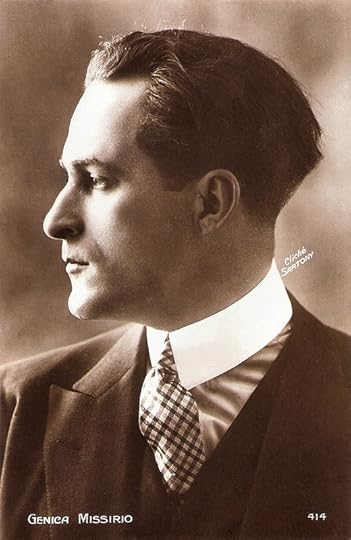
French postcard by Editions Cinémagazine, no. 414. Photo: Sartony.
A Huge Commercial Success
Little is known about Genica Missirio, which seems odd, as he was quite a popular actor in French silent cinema of the 1920s.
Missirio was born in Craoiva, Romania in 1895. He had his breakthrough as film actor in the Orientalist adventure film L’Atlantide/Lost Atlantis (Jacques Feyder, 1921). The stars in this adaptation of the Pierre Benoit novel were Jean Angelo , Georges Melchior and Stacia Napierkowska .
Missirio played the captain Aymard, who at the beginning of the film finds lieutenant Saint-Avit (Melchior) in the desert, almost dead. Recovered Saint-Avit narrates how desert queen Antinéa (Napierkowska) seduced him in killing his buddy captain Morhange (Angelo) when Morhange rejected Antinéa. A few years after St. Avit cannot forget Antinea and with Aymard he goes back to her, despite of what she has done.
The film, shot on location in the desert, was a huge commercial success but critical reception was less positive, in particular against Napierkowska, now past her prime and too rotund to be a femme fatale. A rare tinted nitrate copy was found and restored by the Netherlands Filmmuseum (now EYE), in combination with the French intertitles from a French copy, and had its international release at the 1992 Bologna film festival. In 2004 the Dutch restored print was released on DVD by Lobster, and in 2006 again by Home Vision Entertainment on the DVD Rediscover Jacques Feyder.
After L’Atlantide, Missirio was Serge Tchérenkol in Les ailes s’ouvrent/The Wings Open (Guy du Fresnay, 1921), opposite André Roanne and another actress from L’Atlantide: Marie-Louise Iribe. In 1922 he had the male lead in Du Fresnay’s comedy Margot, with Gina Palerme in the title role.
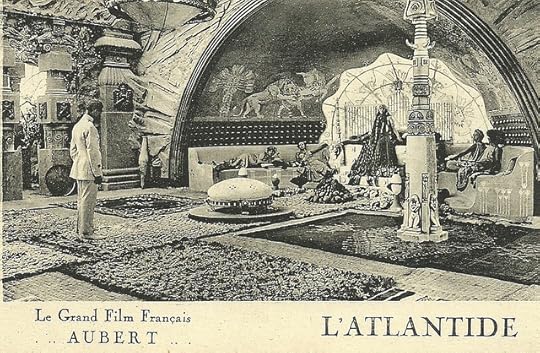
French postcard for the Louis Aubert production L'Atlantide (1921) by Jacques Feyder, based on the novel by Pierre Benoit. The card depicts the French captain Morhange ( Jean Angelo ) received by the mysterious and cruel desert queen Antinéa ( Stacia Napierkowska ). The sets were by Manuel Orazi.
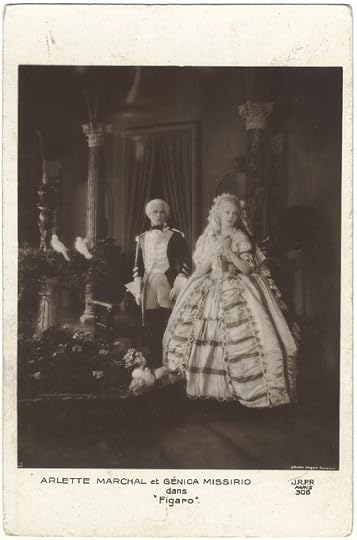
French postcard by P.R.P.R., Paris, no. 306. Photo: Roger Forster. Arlette Marchal and Genica Missirio in Figaro (1929). Collection: Manuel Palomino Arjona @ Flickr.
Notorious Gang Leader
In 1923 Genica Missirio played L’Aristo, a notorious gang leader, in Jean Kemm’s adaptation of Arthur Bernède’s popular novel Vidoq. René Navarre played the title role, and his co-stars were Elmire Vautier , Rachel Devirys and Dolly Davis . In the same year he also acted in La bouquetière des innocents/The Innocent Flower Girl (Jacques Robert, 1923) the part of Concini, favourite of the French Queen of Medici and first minister of France, but hated by the French and finally killed on instigation of king Louis XIII. Claude Merelle was the star of the film, playing the double role of Concini’s scheming wife Leonor, lady-in-waiting of the queen, as well as Margot, the innocent flower girl.
In 1924 Missirio played in Le cavalier de minuit/The midnight rider (R. Alinat, Maurice Champeroy, 1924), starring André Nox and Gina Manès . In the same year he had the male lead in the Albatros production L’affiche/The Poster (Jean Epstein, 1924), with Nathalie Lissenko as his love interest.
In 1926 Missirio acted in L’espionne aux yeux noirs/The black-eyed spy by Henri Desfontaines and in another Pierre Benoit adaptation Le soleil de minuit/The midnight sun by Richard Garrick and Jean Legrand.
In 1927 Missirio was highly active. He played opposite René Navarre in both Poker d’as/Poker of aces (Henri Desfontaines, 1927) and Belphégor (Henri Desfontaines, 1927). He was Joachim Murat opposite Albert Diedonné as Napoleon in Abel Gance ’s epic Napoléon (1927). He also played the love interest of France Dhélia opposite Constant Rémy in Le chemin de la gloire/The road to glory (Gaston Roudès, 1927) and had the male lead in Le prince Zilah/Prince Zilah (Gaston Roudès, 1927) with France Dhélia .
Genica Missirio’s last films were Madame Recamier (Gaston Tavel, Tony Lekain, 1928) starring Marie Bell - Missirio played Lucien Bonaparte, and Figaro (Gaston Tavel, 1929) starring Edmond Van Duren and Arlette Marchal .
Possibly because of his foreign accent, Genica Missirio never made the passage to sound cinema and quitted film acting. Unknown is when or where he died.
L’Atlantide (1921) (complete film). Source: ArchivesNumCineDZ (YouTube).
Sources: Cineressources and .

French postcard by Editions Cinémagazine, no. 414. Photo: Sartony.
A Huge Commercial Success
Little is known about Genica Missirio, which seems odd, as he was quite a popular actor in French silent cinema of the 1920s.
Missirio was born in Craoiva, Romania in 1895. He had his breakthrough as film actor in the Orientalist adventure film L’Atlantide/Lost Atlantis (Jacques Feyder, 1921). The stars in this adaptation of the Pierre Benoit novel were Jean Angelo , Georges Melchior and Stacia Napierkowska .
Missirio played the captain Aymard, who at the beginning of the film finds lieutenant Saint-Avit (Melchior) in the desert, almost dead. Recovered Saint-Avit narrates how desert queen Antinéa (Napierkowska) seduced him in killing his buddy captain Morhange (Angelo) when Morhange rejected Antinéa. A few years after St. Avit cannot forget Antinea and with Aymard he goes back to her, despite of what she has done.
The film, shot on location in the desert, was a huge commercial success but critical reception was less positive, in particular against Napierkowska, now past her prime and too rotund to be a femme fatale. A rare tinted nitrate copy was found and restored by the Netherlands Filmmuseum (now EYE), in combination with the French intertitles from a French copy, and had its international release at the 1992 Bologna film festival. In 2004 the Dutch restored print was released on DVD by Lobster, and in 2006 again by Home Vision Entertainment on the DVD Rediscover Jacques Feyder.
After L’Atlantide, Missirio was Serge Tchérenkol in Les ailes s’ouvrent/The Wings Open (Guy du Fresnay, 1921), opposite André Roanne and another actress from L’Atlantide: Marie-Louise Iribe. In 1922 he had the male lead in Du Fresnay’s comedy Margot, with Gina Palerme in the title role.

French postcard for the Louis Aubert production L'Atlantide (1921) by Jacques Feyder, based on the novel by Pierre Benoit. The card depicts the French captain Morhange ( Jean Angelo ) received by the mysterious and cruel desert queen Antinéa ( Stacia Napierkowska ). The sets were by Manuel Orazi.

French postcard by P.R.P.R., Paris, no. 306. Photo: Roger Forster. Arlette Marchal and Genica Missirio in Figaro (1929). Collection: Manuel Palomino Arjona @ Flickr.
Notorious Gang Leader
In 1923 Genica Missirio played L’Aristo, a notorious gang leader, in Jean Kemm’s adaptation of Arthur Bernède’s popular novel Vidoq. René Navarre played the title role, and his co-stars were Elmire Vautier , Rachel Devirys and Dolly Davis . In the same year he also acted in La bouquetière des innocents/The Innocent Flower Girl (Jacques Robert, 1923) the part of Concini, favourite of the French Queen of Medici and first minister of France, but hated by the French and finally killed on instigation of king Louis XIII. Claude Merelle was the star of the film, playing the double role of Concini’s scheming wife Leonor, lady-in-waiting of the queen, as well as Margot, the innocent flower girl.
In 1924 Missirio played in Le cavalier de minuit/The midnight rider (R. Alinat, Maurice Champeroy, 1924), starring André Nox and Gina Manès . In the same year he had the male lead in the Albatros production L’affiche/The Poster (Jean Epstein, 1924), with Nathalie Lissenko as his love interest.
In 1926 Missirio acted in L’espionne aux yeux noirs/The black-eyed spy by Henri Desfontaines and in another Pierre Benoit adaptation Le soleil de minuit/The midnight sun by Richard Garrick and Jean Legrand.
In 1927 Missirio was highly active. He played opposite René Navarre in both Poker d’as/Poker of aces (Henri Desfontaines, 1927) and Belphégor (Henri Desfontaines, 1927). He was Joachim Murat opposite Albert Diedonné as Napoleon in Abel Gance ’s epic Napoléon (1927). He also played the love interest of France Dhélia opposite Constant Rémy in Le chemin de la gloire/The road to glory (Gaston Roudès, 1927) and had the male lead in Le prince Zilah/Prince Zilah (Gaston Roudès, 1927) with France Dhélia .
Genica Missirio’s last films were Madame Recamier (Gaston Tavel, Tony Lekain, 1928) starring Marie Bell - Missirio played Lucien Bonaparte, and Figaro (Gaston Tavel, 1929) starring Edmond Van Duren and Arlette Marchal .
Possibly because of his foreign accent, Genica Missirio never made the passage to sound cinema and quitted film acting. Unknown is when or where he died.
L’Atlantide (1921) (complete film). Source: ArchivesNumCineDZ (YouTube).
Sources: Cineressources and .
Published on November 03, 2013 23:00
Lisa Gastoni
Gorgeous Lisa Gastoni (1935) is an Italian film actress, who started her career with small parts in British films. In the 1960s and 1970s she became a sensual leading lady of the Italian cinema, who won several awards.
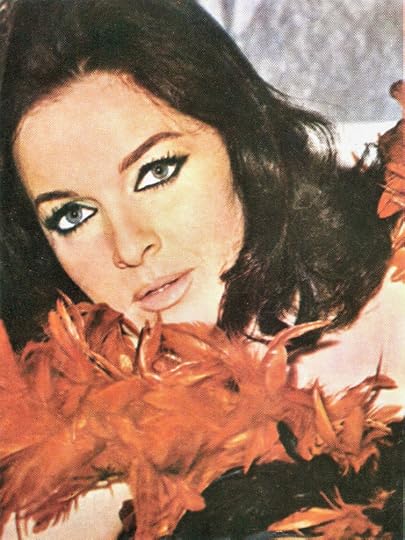
Yugoslavian postcard by Cik Razglednica.
Diabolical School Girl
Lisa (sometimes Liza) Gastoni was born Elisabetta Gastone in Alassio, Italy in 1935. She was the daughter of an Italian father and an Irish mother. She moved to England after World War II and there began her film and modelling career.
In 1954 she had a small part as Lisa Gastoni in the comedy Doctor in the House (Ralph Thomas, 1954) based on the novel by Richard Gordon, which follows a group of students through medical school. Doctor in the House was the most popular box office film of 1954 in Great Britain and made of Dirk Bogarde a big star.
She played more small roles in comedies like Man of the Moment (John Paddy Carstairs, 1955) featuring Norman Wisdom, The Baby and the Battleship (Jay Lewis, 1956) starring John Mills and Richard Attenborough , and Three Men in a Boat (Ken Annakin, 1956) with Laurence Harvey .
Gastoni was one the diabolical school girls in Blue Murder at St Trinian's (Frank Launder, 1957), the sequel to The Belles of St. Trinian's (Frank Launder, 1954), set in Ronald Searle's fictional St Trinian's Girls School.
Throughout the 1950s, Gastoni appeared in various B-films such as the romantic comedy Second Fiddle (Maurice Elvey, 1957) with Adrienne Corri , the thriller Intent to Kill (Jack Cardiff, 1958) starring Richard Todd, and the crime film The Breaking Point (Lance Comfort, 1961). She also co-starred as Giulia in the popular TV series The Four Just Men (1959-1960) and appeared in some episodes of the hit series Danger Man (1960–1961), starring Patrick McGoohan .
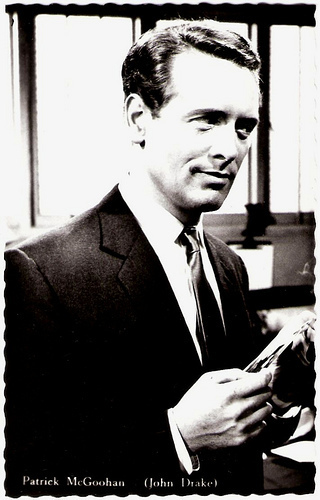
Patrick McGoohan in Danger Man. Dutch postcard. Publicity still for the TV series Danger Man (1960-1961).
Swashbucklers And Peplums
Lisa Gastoni returned to Italy in the 1960s. In 1961, she featured in Le avventure di Mary Read/Queen of the Seas (Umberto Lenzi, 1961). She appeared in such Swashbucklers as I quattro moschettieri/The Four Musketeers (Carlo Ludovico Bragaglia, 1963) and in Peplums, the Italian sword-and-sandal films, like Tharus figlio di Attila/Colussus and the Huns (Roberto Bianchi Montero, 1962).
Gastoni had a small part in the melodrama Eva (Joseph Losey, 1962) featuring Jeanne Moreau . In 1965 she played the female lead in the science fiction horror film I Criminali della Galassia/Wild, Wild Planet (Antonio Margheriti, 1965). The low-budget aesthetics and general cheesy vibe of the picture have made it a cult favourite. Also interesting was the atmospheric Giallo Le notti della violenza/Callgirls 66 (Roberto Mauri, 1965).
Eventually Lisa Gastoni gained the attention of respected directors. She co-starred in the crime drama Svegliati e uccidi/Wake Up and Die (Carlo Lizzani, 1966), based on the real life of Italian criminal Luciano Lutring ( Robert Hoffmann ), aka ‘il solista del mitra’ (the machine-gun soloist). For her role as Lutring’s wife, she was awarded with the Nastro d'Argento (Silver Ribbon) for Best Actress.
The turning point in her film career was her role as the sensual aunt of wheelchair bound Lou Castel in Grazie, zia/Come Play with Me (Salvatore Samperi, 1968). The drama was listed to compete at the Cannes Film Festival, but the festival was cancelled due to the May 1968 events. This part would set the tone for the roles she would play for the next decade; attractive bourgeois women who were seductive yet sexually frustrated.
Her later films include such erotic dramas as Maddalena (Jerzy Kawalerowicz, 1971) and La seduzione/Seduction (Fernando Di Leo, 1973) with Maurice Ronet . At the time of the latter’s release, the newspapers widely reported the news of a man who died of a heart attack watching the film. She was awarded with a Silver Ribbon for Best Actress for her role in the drama Amore amaro/Bitter Love (Florestano Vancini, 1974). Later followed Scandalo/Scandal (Salvatore Samperi, 1976) with Franco Nero , and the thriller L'immoralità/Cock Crows at Eleven (Massimo Pirri, 1978).
After 1979, Gastoni retired from acting for over 20 years, focusing on painting and writing. She returned to the screen in Cuore sacro/Sacred heart (Ferzan Özpetek, 2005) as the mother of an workaholic businesswoman (Barbora Bobulova). The film won two David di Donatello awards, including one for Bobulova as Best Actress. Since then Lisa Gastoni played several supporting parts in films and on TV.
Trailer I Criminali della Galassia/Wild, Wild Planet (1965). Source: Sleaze-o-Rama (YouTube).
Italian trailer Grazie, zia/Come Play with Me (1968). Source: CGHomeVideo (YouTube).
Sources: AllMovie, Wikipedia, and .

Yugoslavian postcard by Cik Razglednica.
Diabolical School Girl
Lisa (sometimes Liza) Gastoni was born Elisabetta Gastone in Alassio, Italy in 1935. She was the daughter of an Italian father and an Irish mother. She moved to England after World War II and there began her film and modelling career.
In 1954 she had a small part as Lisa Gastoni in the comedy Doctor in the House (Ralph Thomas, 1954) based on the novel by Richard Gordon, which follows a group of students through medical school. Doctor in the House was the most popular box office film of 1954 in Great Britain and made of Dirk Bogarde a big star.
She played more small roles in comedies like Man of the Moment (John Paddy Carstairs, 1955) featuring Norman Wisdom, The Baby and the Battleship (Jay Lewis, 1956) starring John Mills and Richard Attenborough , and Three Men in a Boat (Ken Annakin, 1956) with Laurence Harvey .
Gastoni was one the diabolical school girls in Blue Murder at St Trinian's (Frank Launder, 1957), the sequel to The Belles of St. Trinian's (Frank Launder, 1954), set in Ronald Searle's fictional St Trinian's Girls School.
Throughout the 1950s, Gastoni appeared in various B-films such as the romantic comedy Second Fiddle (Maurice Elvey, 1957) with Adrienne Corri , the thriller Intent to Kill (Jack Cardiff, 1958) starring Richard Todd, and the crime film The Breaking Point (Lance Comfort, 1961). She also co-starred as Giulia in the popular TV series The Four Just Men (1959-1960) and appeared in some episodes of the hit series Danger Man (1960–1961), starring Patrick McGoohan .

Patrick McGoohan in Danger Man. Dutch postcard. Publicity still for the TV series Danger Man (1960-1961).
Swashbucklers And Peplums
Lisa Gastoni returned to Italy in the 1960s. In 1961, she featured in Le avventure di Mary Read/Queen of the Seas (Umberto Lenzi, 1961). She appeared in such Swashbucklers as I quattro moschettieri/The Four Musketeers (Carlo Ludovico Bragaglia, 1963) and in Peplums, the Italian sword-and-sandal films, like Tharus figlio di Attila/Colussus and the Huns (Roberto Bianchi Montero, 1962).
Gastoni had a small part in the melodrama Eva (Joseph Losey, 1962) featuring Jeanne Moreau . In 1965 she played the female lead in the science fiction horror film I Criminali della Galassia/Wild, Wild Planet (Antonio Margheriti, 1965). The low-budget aesthetics and general cheesy vibe of the picture have made it a cult favourite. Also interesting was the atmospheric Giallo Le notti della violenza/Callgirls 66 (Roberto Mauri, 1965).
Eventually Lisa Gastoni gained the attention of respected directors. She co-starred in the crime drama Svegliati e uccidi/Wake Up and Die (Carlo Lizzani, 1966), based on the real life of Italian criminal Luciano Lutring ( Robert Hoffmann ), aka ‘il solista del mitra’ (the machine-gun soloist). For her role as Lutring’s wife, she was awarded with the Nastro d'Argento (Silver Ribbon) for Best Actress.
The turning point in her film career was her role as the sensual aunt of wheelchair bound Lou Castel in Grazie, zia/Come Play with Me (Salvatore Samperi, 1968). The drama was listed to compete at the Cannes Film Festival, but the festival was cancelled due to the May 1968 events. This part would set the tone for the roles she would play for the next decade; attractive bourgeois women who were seductive yet sexually frustrated.
Her later films include such erotic dramas as Maddalena (Jerzy Kawalerowicz, 1971) and La seduzione/Seduction (Fernando Di Leo, 1973) with Maurice Ronet . At the time of the latter’s release, the newspapers widely reported the news of a man who died of a heart attack watching the film. She was awarded with a Silver Ribbon for Best Actress for her role in the drama Amore amaro/Bitter Love (Florestano Vancini, 1974). Later followed Scandalo/Scandal (Salvatore Samperi, 1976) with Franco Nero , and the thriller L'immoralità/Cock Crows at Eleven (Massimo Pirri, 1978).
After 1979, Gastoni retired from acting for over 20 years, focusing on painting and writing. She returned to the screen in Cuore sacro/Sacred heart (Ferzan Özpetek, 2005) as the mother of an workaholic businesswoman (Barbora Bobulova). The film won two David di Donatello awards, including one for Bobulova as Best Actress. Since then Lisa Gastoni played several supporting parts in films and on TV.
Trailer I Criminali della Galassia/Wild, Wild Planet (1965). Source: Sleaze-o-Rama (YouTube).
Italian trailer Grazie, zia/Come Play with Me (1968). Source: CGHomeVideo (YouTube).
Sources: AllMovie, Wikipedia, and .
Published on November 03, 2013 00:00
November 2, 2013
Casanova (1927)
In the next ten weeks, we will present you ten new film specials. Today we start with the silent classic Casanova (1927), directed by Russian director Alexandre Volkoff aka Aleksandr Volkoff. Starring as the well-known Venetian gentleman, lover, poet and inventor is the legendary Russian actor Ivan Mozzhukhin in his most famous role.
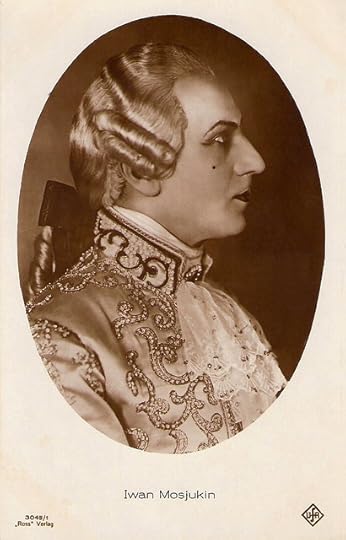
Ivan Mozzhukhin in Casanova (1927). German postcard by Ross Verlag, no. 3948/1, 1928-1929. Photo: Ufa.
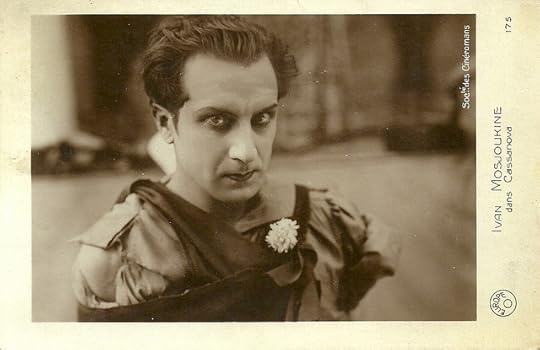
Ivan Mozzhukhin . French postcard by Europe, no. 175. Photo: Société des Cinéromans.
Always In The Service Of Women
Casanova shows Ivan Mozzhukhin at his best and his most light hearted. In the film he makes everything seem easy. As you can notice on the postcards, his name was spelled Ivan Mosjoukine in French, Iwan Mosjukin in German, and Ivan Mosjoukine in English.
The film is a far-from-accurate biopic of legendary Italian lover. Casanova is episodic in structure, almost like a collection of short stories. Casanova bounces from one adventure to another, going on 'secret missions' from Venice to Austria to Russia and finally back to Venice again.
He is always in the service of women, as he puts it in a letter to a man he has good-naturedly robbed. In the end, all his romancing catches up with him, and he is forced to choose between two women.
Though partly shot on location in Venice, Casanova was a French-German production.
Director Alexandre Volkoff was one of a significant number of film industry exiles who fled Russia following the Bolshevik takeover. Volfkoff worked in France for many years, and also made films in Germany and Italy.
The film also presented a pan-European cast. Casanova's delectable females include for instance French actress Suzanne Bianchetti as Catherine II the Great, Italian diva Rina De Liguoro, and German star Jenny Jugo as the lovely Therese who finally captures the protagonist's heart.
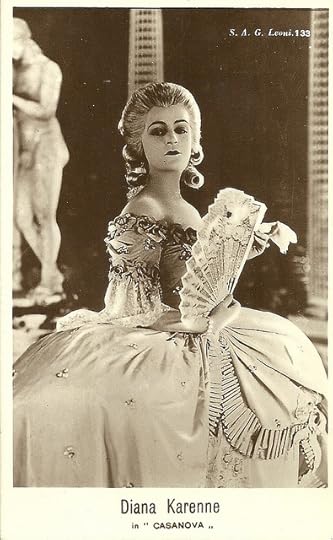
Diana Karenne . Italian postcard by G.B. Falci, Milano, no. 133. Photo: Distr. S.A.G. Leoni.
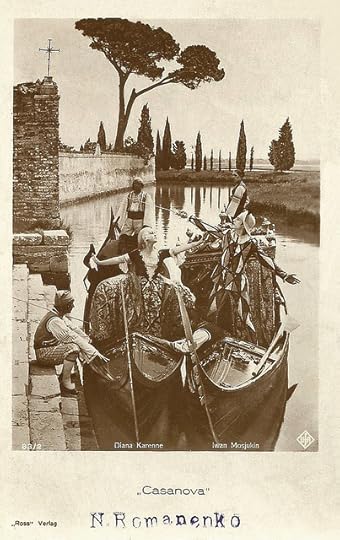
Diana Karenne and Ivan Mozzhukhin . German postcard by Ross Verlag, no. 83/2. Photo: Ufa
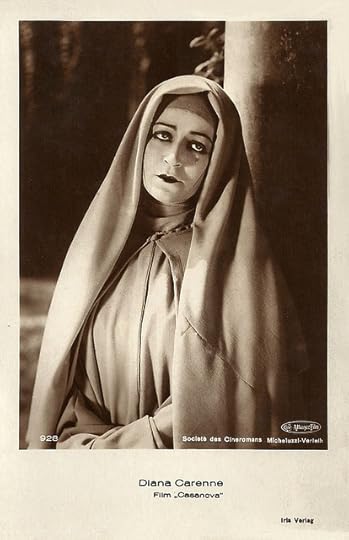
Diana Karenne . Austrian postcard by Iris Verlag, no. 928. Photo: Société des Cineromans / Micheluzzi-Verleih / Cine Alliance Film.
One Of The True Divas
Pictured on the Ross postcard above is a carnival scene in Casanova with the Italian lover and his catch Maria, the Duchess de Lardi.
Maria was played by Polish actress Diana Karenne , one of the true divas of the Italian silent cinema.
Between 1916 and 1920, Karenne fascinated European audiences with her eccentric dresses and make-up, and with her prima donna behaviour.
The scene on the postcard was shot near the Venice cemetery Isola di San Michele.
With its panoramic location photograph and its lavish re-creation of decadent 18th century Venice, the visual style of Casanova is wonderful. There is even one long scene filmed in colour. The public follows Ivan Mozzhukhin through various chases, rescues, romantic liaisons, and hairbreadth escapes and this makes of this silent version of Casanova a spectacular, picaresque epic.
Hal Erickson at AllMovie : "The film ran into some curious censorship troubles in the U.S., and as result it was retitled Prince of Adventurers, with the main character rechristened as 'Roberto Ferrara'!"
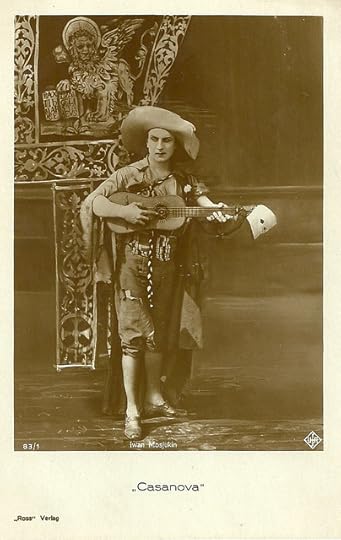
Ivan Mozzhukhin . German postcard by Ross Verlag, no. 83/1. Photo: Ufa.
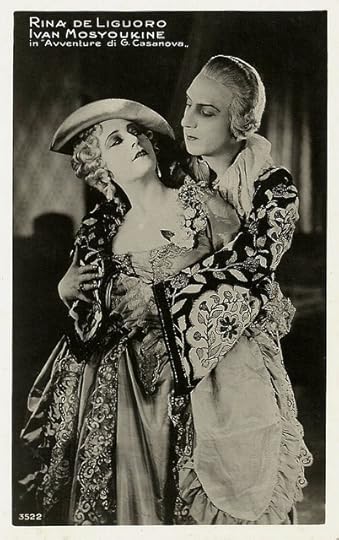
Rina De Liguoro and Ivan Mozzhukhin . Italian postcard by Ed. Vettori, Bologna, no. 3522.
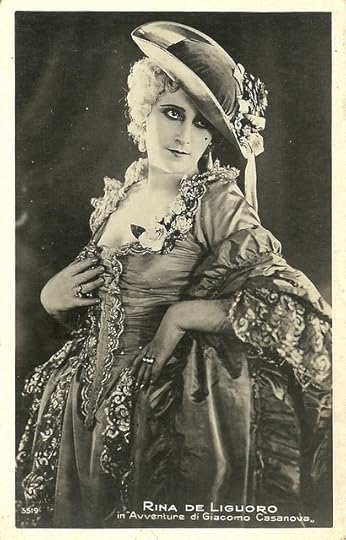
Rina De Liguoro . Italian postcard, no. 3519.
Sources: Hal Erickson (AllMovie), Wikipedia and IMDb.

Ivan Mozzhukhin in Casanova (1927). German postcard by Ross Verlag, no. 3948/1, 1928-1929. Photo: Ufa.

Ivan Mozzhukhin . French postcard by Europe, no. 175. Photo: Société des Cinéromans.
Always In The Service Of Women
Casanova shows Ivan Mozzhukhin at his best and his most light hearted. In the film he makes everything seem easy. As you can notice on the postcards, his name was spelled Ivan Mosjoukine in French, Iwan Mosjukin in German, and Ivan Mosjoukine in English.
The film is a far-from-accurate biopic of legendary Italian lover. Casanova is episodic in structure, almost like a collection of short stories. Casanova bounces from one adventure to another, going on 'secret missions' from Venice to Austria to Russia and finally back to Venice again.
He is always in the service of women, as he puts it in a letter to a man he has good-naturedly robbed. In the end, all his romancing catches up with him, and he is forced to choose between two women.
Though partly shot on location in Venice, Casanova was a French-German production.
Director Alexandre Volkoff was one of a significant number of film industry exiles who fled Russia following the Bolshevik takeover. Volfkoff worked in France for many years, and also made films in Germany and Italy.
The film also presented a pan-European cast. Casanova's delectable females include for instance French actress Suzanne Bianchetti as Catherine II the Great, Italian diva Rina De Liguoro, and German star Jenny Jugo as the lovely Therese who finally captures the protagonist's heart.

Diana Karenne . Italian postcard by G.B. Falci, Milano, no. 133. Photo: Distr. S.A.G. Leoni.

Diana Karenne and Ivan Mozzhukhin . German postcard by Ross Verlag, no. 83/2. Photo: Ufa

Diana Karenne . Austrian postcard by Iris Verlag, no. 928. Photo: Société des Cineromans / Micheluzzi-Verleih / Cine Alliance Film.
One Of The True Divas
Pictured on the Ross postcard above is a carnival scene in Casanova with the Italian lover and his catch Maria, the Duchess de Lardi.
Maria was played by Polish actress Diana Karenne , one of the true divas of the Italian silent cinema.
Between 1916 and 1920, Karenne fascinated European audiences with her eccentric dresses and make-up, and with her prima donna behaviour.
The scene on the postcard was shot near the Venice cemetery Isola di San Michele.
With its panoramic location photograph and its lavish re-creation of decadent 18th century Venice, the visual style of Casanova is wonderful. There is even one long scene filmed in colour. The public follows Ivan Mozzhukhin through various chases, rescues, romantic liaisons, and hairbreadth escapes and this makes of this silent version of Casanova a spectacular, picaresque epic.
Hal Erickson at AllMovie : "The film ran into some curious censorship troubles in the U.S., and as result it was retitled Prince of Adventurers, with the main character rechristened as 'Roberto Ferrara'!"

Ivan Mozzhukhin . German postcard by Ross Verlag, no. 83/1. Photo: Ufa.

Rina De Liguoro and Ivan Mozzhukhin . Italian postcard by Ed. Vettori, Bologna, no. 3522.

Rina De Liguoro . Italian postcard, no. 3519.
Sources: Hal Erickson (AllMovie), Wikipedia and IMDb.
Published on November 02, 2013 00:00
November 1, 2013
Anna Dammann
Beautiful Anna Dammann (1912-1993) was one of the major theatre actresses of Germany in the 20th Century. In 1932 she debuted on the stage as Brunhild in Friedrich Hebbel’s Die Nibelungen and would go on to play leading roles in many famous classic and modern plays. Sadly she appeared only in a few, not very outstanding films.

German postcard by Film-Foto-Verlag, no. G 162. Photo: Ruth Wilhelmi.
City Girl
Anna Dammann was born as Edith Geese in Altona (now Hamburg), Germany, in 1912. She attended a high school for girls and from 1930 till 1932 she had acting lessons from Albrecht Schoenhals.
After theatre engagements in Frankfurt an der Oder, Wuppertal, Stuttgart und Düsseldorf, she came to work at the Deutsche Theater in Berlin in 1937. Till 1945, she played many classic female roles like Antigone, Mary Stuart, Cassandra, Cleopatra and the The Maid of Orleans.
Her first film was Oberwachtmeister Schwenke (Carl Froelich, 1935) starring Gustav Fröhlich .
Her next appearance was as the city girl in Die Reise nach Tilsit/The Trip to Tilsit ( Veit Harlan , 1939) who lures fisherman Frits van Dongen (aka Philip Dorn) away from his wife, Kristina Söderbaum . It was her first leading part.
This sound remake of F.W. Murnau's classic silent film Sunrise (1927) was a far more earthy, darker and more realistic adaptation of the short story by Hermann Sudermann. It was shot in Memel, where the action takes place.

German postcard by Film-Foto-Verlag, no. A 3780/1, 1941-1944. Photo: Ruth Wilhelmi.
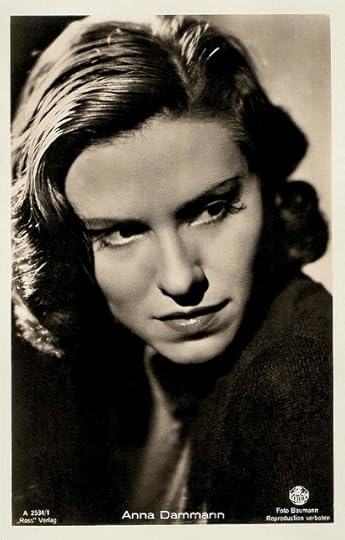
German postcard by Ross Verlag, no. A 2534/1, 1941-1944. Photo: Baumann / Terra.
Anti-British Propaganda
Anna Dammann next starred in Johannisfeuer/St. John's Fire (Arthur Maria Rabenalt, 1939) with Ernst von Klipstein.
Dammann appeared in the propaganda film Mein Leben für Irland/My Life for Ireland (Max W. Kimmich, 1941) with René Deltgen , The film covered a story of Irish heroism and martyrdom over two generations under the occupation of the evil British. Mein Leben für Irland was produced for Nazi-occupied Europe with the intent of challenging pro-British allegiances. However, Wikipedia writes that instead audiences identified the Irish struggle with their own resistance against the Nazis.
During the war years, she also starred in Nacht ohne Abschied/Night Without Goodbye (Erich Waschneck, 1943) with Karl Ludwig Diehl, and Gefährtin meines Sommers/My Summer Companion (Fritz Peter Buch, 1943) opposite Paul Hartmann .
After WWII she played merely on stage. She appeared in only one more film, under the name Anna Dannemann, in Oberarzt Dr. Solm/Senior Physician Dr. Solm (Paul May, 1955) with Hans Söhnker.
Incidentally she appeared on television, like in Die Troerinnen des Euripides/The Trojan Women of Euripides (Paul Verhoeven, 1959).
Anna Dammann died in 1993 in Munich, Germany. She was married to businessman and art researcher Walter Geese and with whom she had a daughter.
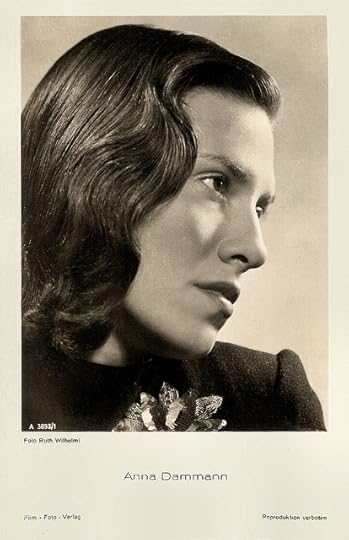
German postcard by Film-Foto-Verlag, no. A 3893/1, 1941-1944. Photo: Ruth Wilhelmi.
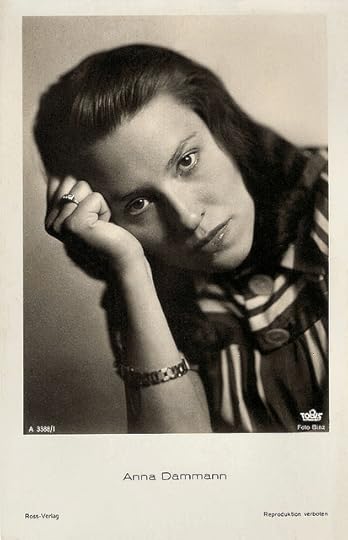
German postcard by Ross Verlag, no. A 3388/1, 1941-1944. Photo: Binz / Tobis.
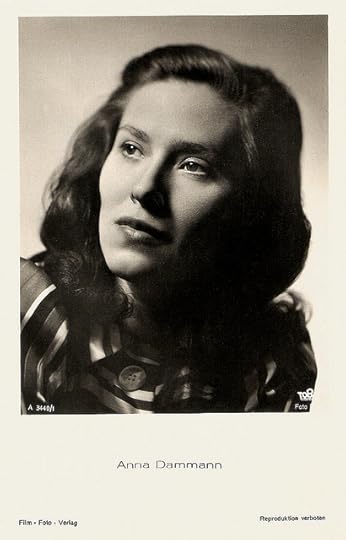
German postcard by Film-Foto-Verlag, no. A 3440, 1941-1944. Photo: Binz / Tobis.
Sources: Stephanie d'Heil (Steffi-line.de) (German), Thomas Staedeli (Cyranos), Wikipedia (German and English) and .

German postcard by Film-Foto-Verlag, no. G 162. Photo: Ruth Wilhelmi.
City Girl
Anna Dammann was born as Edith Geese in Altona (now Hamburg), Germany, in 1912. She attended a high school for girls and from 1930 till 1932 she had acting lessons from Albrecht Schoenhals.
After theatre engagements in Frankfurt an der Oder, Wuppertal, Stuttgart und Düsseldorf, she came to work at the Deutsche Theater in Berlin in 1937. Till 1945, she played many classic female roles like Antigone, Mary Stuart, Cassandra, Cleopatra and the The Maid of Orleans.
Her first film was Oberwachtmeister Schwenke (Carl Froelich, 1935) starring Gustav Fröhlich .
Her next appearance was as the city girl in Die Reise nach Tilsit/The Trip to Tilsit ( Veit Harlan , 1939) who lures fisherman Frits van Dongen (aka Philip Dorn) away from his wife, Kristina Söderbaum . It was her first leading part.
This sound remake of F.W. Murnau's classic silent film Sunrise (1927) was a far more earthy, darker and more realistic adaptation of the short story by Hermann Sudermann. It was shot in Memel, where the action takes place.

German postcard by Film-Foto-Verlag, no. A 3780/1, 1941-1944. Photo: Ruth Wilhelmi.

German postcard by Ross Verlag, no. A 2534/1, 1941-1944. Photo: Baumann / Terra.
Anti-British Propaganda
Anna Dammann next starred in Johannisfeuer/St. John's Fire (Arthur Maria Rabenalt, 1939) with Ernst von Klipstein.
Dammann appeared in the propaganda film Mein Leben für Irland/My Life for Ireland (Max W. Kimmich, 1941) with René Deltgen , The film covered a story of Irish heroism and martyrdom over two generations under the occupation of the evil British. Mein Leben für Irland was produced for Nazi-occupied Europe with the intent of challenging pro-British allegiances. However, Wikipedia writes that instead audiences identified the Irish struggle with their own resistance against the Nazis.
During the war years, she also starred in Nacht ohne Abschied/Night Without Goodbye (Erich Waschneck, 1943) with Karl Ludwig Diehl, and Gefährtin meines Sommers/My Summer Companion (Fritz Peter Buch, 1943) opposite Paul Hartmann .
After WWII she played merely on stage. She appeared in only one more film, under the name Anna Dannemann, in Oberarzt Dr. Solm/Senior Physician Dr. Solm (Paul May, 1955) with Hans Söhnker.
Incidentally she appeared on television, like in Die Troerinnen des Euripides/The Trojan Women of Euripides (Paul Verhoeven, 1959).
Anna Dammann died in 1993 in Munich, Germany. She was married to businessman and art researcher Walter Geese and with whom she had a daughter.

German postcard by Film-Foto-Verlag, no. A 3893/1, 1941-1944. Photo: Ruth Wilhelmi.

German postcard by Ross Verlag, no. A 3388/1, 1941-1944. Photo: Binz / Tobis.

German postcard by Film-Foto-Verlag, no. A 3440, 1941-1944. Photo: Binz / Tobis.
Sources: Stephanie d'Heil (Steffi-line.de) (German), Thomas Staedeli (Cyranos), Wikipedia (German and English) and .
Published on November 01, 2013 00:00
October 31, 2013
Barbara Brylska
During the 1970s, Polish actress Barbara Brylska (1941) was featured in numerous films throughout the countries of the Warsaw Pact. She is noted especially for her role as Nadya in the classic Soviet comedy Ironiya sudby/Irony of Fate (1975).

East-German postcard by VEB Progress Film-Vertrieb, Berlin, no. 2709, 1966. Retail price: 0,20 MDN. Photo: Balinski.
Phoenician Priestess
Barbara Brylska was born in Skotniki, near Łódź, Poland in 1941. Her early childhood was marked by the trauma of survival under the Nazi occupation of Poland during the Second World War.
At the age of 15, she played a bit part in the film Kalosze szczescia/Lucky Boots (Antoni Bohdziewicz, 1958) with Maria Gella. After this small uncredited role, she took acting lessons at Lodz Theatre School and then studied at Warsaw School of Theatre, Cinema and Television. In 1967 she completed her acting education.
Brylska's first major film role was in the drama Ich dzień powszedni/Their Everyday Life (Aleksander Scibor-Rylski, 1963) opposite ‘the Polish James Dean’ Zbigniew Cybulski . She appeared with Tadeusz Lomnicki and a young Daniel Olbrychski in the war drama Potem nastapi cisza/And All Will Be Quiet (Janusz Morgenstern 1966).
Her appearance in Bumerang/Boomerang (1966) made her one of the most popular actresses in Poland. And the same year, she also played a supporting role as the Phoenician priestess Kama in the Oscar nominated film Faraon/Pharaoh (Jerzy Kawalerowicz, 1966), based on the novel by Bolesław Prus. Star of the three-hour epic historical drama was Jerzy Zelnik as Pharaoh Ramses XIII, with whom she had a relationship.
Brylska married twice, in 1961 to Jan Borovets, and in 1970 to Ludwig Kosmal. In 1968, she played in the East-German Western Spur des Falken/Trail of the Falcon (Gottfried Kolditz,1968) with Gojko Mitic . The next year she played the female lead in the crime mystery Zbrodniarz, który ukradl zbrodnie/The Criminal Who Stole a Crime (Janusz Majewski, 1969), and a supporting role in Pan Wolodyjowski/Colonel Wolodyjowski (Jerzy Hoffman, 1969), featuring Tadeusz Lomnicki.
Hal Erickson at AllMovie : “Polish documentary filmmaker Jerzy Hoffman brought an aura of realism to the sweeping historical epic Colonel Wolodyjowski. Originally running 160 minutes, the film was based on a trilogy of patriotic novels by Henry Sienkiewicz (Quo Vadis?). The story, set in the 17th century, details the bloody struggle on the Eastern border between the Poles and the invading Turkish hordes. Giving the box-office potential of Colonel Wolodyjowski a major boost was the presence in the supporting cast of 24-year-old matinee idol Daniel Olbrychski. Successful in its home country, Colonel Wolodyjowski unfortunately made very little impression outside of Poland; but then, would a biopic of George Washington play well in Warsaw?”
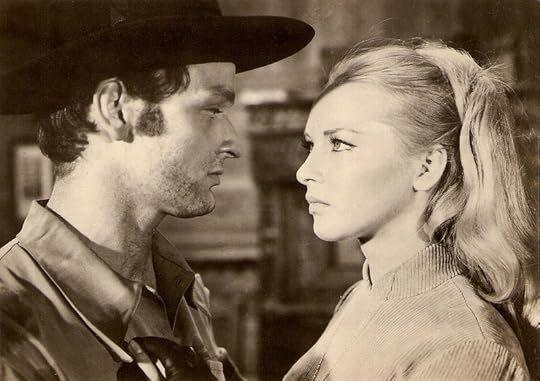
East-German card by VEB Progress Film-Vertrieb, Berlin, no. 89/69, 1969. Retail price: 0,20 MDN. Photo: DEFA. Publicity still for Weisse Wölfe/White Wolves (Bosko Boskovic, Konrad Petzold, 1969).
The Irony of Fate
In the early 1970s, Barbara Brylska played in such Polish (co-)productions as the war film Osvobozhdenie: Napravleniye glavnogo udara/Liberation (Yuri Ozerov 1971), and Anatomia milosci/Anatomy of Love (Roman Zaluski, 1972) with Jan Nowicki. She also played in Russian, Czechoslovak and Bulgarian films.
Her biggest success was the romantic Soviet comedy Ironiya sudby, ili S lyogkim parom!/The Irony of Fate, or Enjoy Your Bath! (Eldar Ryazanov, 1975) opposite Andrey Myagkov. Simultaneously a screwball comedy and a love story tinged with sadness, it is one of the most popular Russian television productions ever.
Originally, the two consecutive episodes of Ironiya sudby were broadcast by Soviet television on 1 January 1976. Author Fedor Razzakov recalled that "virtually the entire country watched the show"; an estimated 100 million viewers. By 1978, after several broadcasts, the accumulated number of viewers was estimated at some 250 million. A shortened 155 minutes version was released to cinemas in August 1976 and sold some 7 million tickets.
In 1977 she was a member of the jury at the 10th Moscow International Film Festival. For her role as Nadya, she was elected as the most popular actress in Russia according to several polls, she also won the State Prize of the USSR (1977). Her acceptance of this award created controversy in her home country.
Steve Shelokhonov at IMDb : “However, Brylska was critical about the rigid political and cultural atmosphere in the Soviet Union. She put her popularity at risk for saying some tough truth about the Soviet regime, albeit the wide Russian audiences were sympathizing with her criticism and understanding of how people were suffering under domination of the Soviet Communist Party.”
She continued to appear regularly on Russian television. Her films in the following decades were less popular, with a few exceptions such as the Czech production Skalpel, prosím/Scalpel, Please (Jirí Svoboda, 1985) with Jana Brejchová. She would later claim that she was caught in political tensions between Poland and the Soviet Union, and her continuing success with Ironiya sudby caused jealousy in the Polish film community and led it to ignore her work. However for the Russian public, Ironiya sudby is now a classic piece of their popular culture and still broadcasted every New Year's Day.
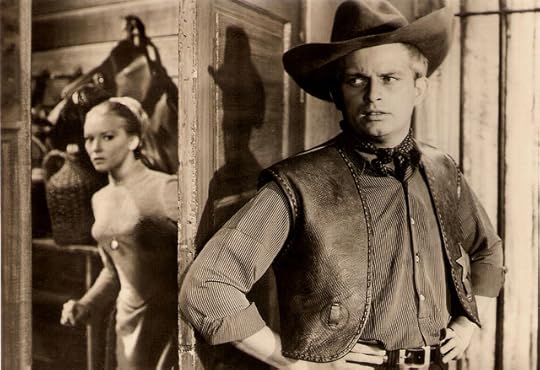
East-German card by VEB Progress Film-Vertrieb, Berlin, no. 89/69, 1969. Retail price: 0,20 MDN. Photo: DEFA. Publicity still for Weisse Wölfe/White Wolves (Bosko Boskovic, Konrad Petzold, 1969) with Karl Zugowski.
Classic Noblesse, Beauty, Intelligence, And Effortless Style
Barbara Brylska had two children with her second husband Ludwig Kosmal, Barbara (1973) and Ludwig (1982). Barbara Kosmal became a model in Paris, but only 20, she died tragically in a car accident. After her daughter’s death and a burglary in her apartment in Warsaw, Brylska suffered from a nervous breakdown, but she continued acting.
After a long screen hiatus, she played a supporting role in Russia in the grotesque crime comedy Daun Haus/Down House (Roman Kachanov, 2000), based on The Idiot by Fyodor Dostoevsky. That same year, she made her stage debut in Moscow, in the popular play Quartet opposite Svetlana Kryuchkova. Since then she primarily acted in Russia, in stage plays and on television, but also in the cinema.
In 2003 she starred in the Russian comedy Casus belli/Symphony of Silence (Igor Ugolnikov, 2003). In 2006 followed the Ukrainian comedy Strannoe Rozhdestvo/Strange Christmas (Maksim Papernik, 2006), reuniting her with Liya Akhedzhakova, who had played her friend in Ironiya sudby. Brylska played Olga Samoilova, a wealthy lady who was forced into a retirement home by her money hungry relatives.
Then Brylska was cast again as the aged Nadya in the sequel to her most popular film, Ironiya sudby. Prodolzhenie/Irony of Fate: The Sequel (Timur Bekmambetov, 2008). Again, it became a box office hit and grossed over $55 million to a production budget of $5 million.
Barbara Brylska remains beloved in Russia and the former Soviet republics for her classic noblesse, beauty, intelligence, and effortless style. Her most recent film is the Polish comedy Milosc na wybiegu/Love on the catwalk (Krzysztof Lang, 2009).
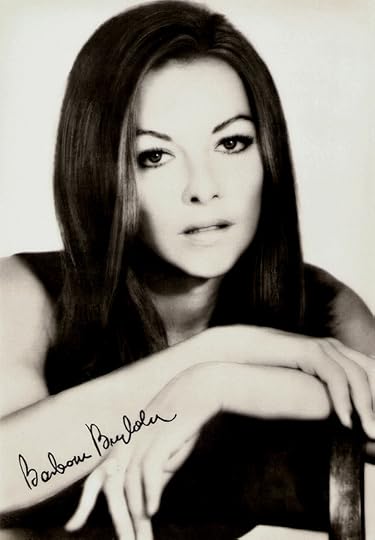
Big East-German card by VEB Progress Film-Vertrieb, Berlin, no. 112/69, 1969. Retail price: 0,40 MDN. Photo: Nasierowska.
Sources: (IMDb), Hal Erickson (AllMovie), Tom B. (Westerns All’Italiana), AllMovie, Wikipedia and .

East-German postcard by VEB Progress Film-Vertrieb, Berlin, no. 2709, 1966. Retail price: 0,20 MDN. Photo: Balinski.
Phoenician Priestess
Barbara Brylska was born in Skotniki, near Łódź, Poland in 1941. Her early childhood was marked by the trauma of survival under the Nazi occupation of Poland during the Second World War.
At the age of 15, she played a bit part in the film Kalosze szczescia/Lucky Boots (Antoni Bohdziewicz, 1958) with Maria Gella. After this small uncredited role, she took acting lessons at Lodz Theatre School and then studied at Warsaw School of Theatre, Cinema and Television. In 1967 she completed her acting education.
Brylska's first major film role was in the drama Ich dzień powszedni/Their Everyday Life (Aleksander Scibor-Rylski, 1963) opposite ‘the Polish James Dean’ Zbigniew Cybulski . She appeared with Tadeusz Lomnicki and a young Daniel Olbrychski in the war drama Potem nastapi cisza/And All Will Be Quiet (Janusz Morgenstern 1966).
Her appearance in Bumerang/Boomerang (1966) made her one of the most popular actresses in Poland. And the same year, she also played a supporting role as the Phoenician priestess Kama in the Oscar nominated film Faraon/Pharaoh (Jerzy Kawalerowicz, 1966), based on the novel by Bolesław Prus. Star of the three-hour epic historical drama was Jerzy Zelnik as Pharaoh Ramses XIII, with whom she had a relationship.
Brylska married twice, in 1961 to Jan Borovets, and in 1970 to Ludwig Kosmal. In 1968, she played in the East-German Western Spur des Falken/Trail of the Falcon (Gottfried Kolditz,1968) with Gojko Mitic . The next year she played the female lead in the crime mystery Zbrodniarz, który ukradl zbrodnie/The Criminal Who Stole a Crime (Janusz Majewski, 1969), and a supporting role in Pan Wolodyjowski/Colonel Wolodyjowski (Jerzy Hoffman, 1969), featuring Tadeusz Lomnicki.
Hal Erickson at AllMovie : “Polish documentary filmmaker Jerzy Hoffman brought an aura of realism to the sweeping historical epic Colonel Wolodyjowski. Originally running 160 minutes, the film was based on a trilogy of patriotic novels by Henry Sienkiewicz (Quo Vadis?). The story, set in the 17th century, details the bloody struggle on the Eastern border between the Poles and the invading Turkish hordes. Giving the box-office potential of Colonel Wolodyjowski a major boost was the presence in the supporting cast of 24-year-old matinee idol Daniel Olbrychski. Successful in its home country, Colonel Wolodyjowski unfortunately made very little impression outside of Poland; but then, would a biopic of George Washington play well in Warsaw?”

East-German card by VEB Progress Film-Vertrieb, Berlin, no. 89/69, 1969. Retail price: 0,20 MDN. Photo: DEFA. Publicity still for Weisse Wölfe/White Wolves (Bosko Boskovic, Konrad Petzold, 1969).
The Irony of Fate
In the early 1970s, Barbara Brylska played in such Polish (co-)productions as the war film Osvobozhdenie: Napravleniye glavnogo udara/Liberation (Yuri Ozerov 1971), and Anatomia milosci/Anatomy of Love (Roman Zaluski, 1972) with Jan Nowicki. She also played in Russian, Czechoslovak and Bulgarian films.
Her biggest success was the romantic Soviet comedy Ironiya sudby, ili S lyogkim parom!/The Irony of Fate, or Enjoy Your Bath! (Eldar Ryazanov, 1975) opposite Andrey Myagkov. Simultaneously a screwball comedy and a love story tinged with sadness, it is one of the most popular Russian television productions ever.
Originally, the two consecutive episodes of Ironiya sudby were broadcast by Soviet television on 1 January 1976. Author Fedor Razzakov recalled that "virtually the entire country watched the show"; an estimated 100 million viewers. By 1978, after several broadcasts, the accumulated number of viewers was estimated at some 250 million. A shortened 155 minutes version was released to cinemas in August 1976 and sold some 7 million tickets.
In 1977 she was a member of the jury at the 10th Moscow International Film Festival. For her role as Nadya, she was elected as the most popular actress in Russia according to several polls, she also won the State Prize of the USSR (1977). Her acceptance of this award created controversy in her home country.
Steve Shelokhonov at IMDb : “However, Brylska was critical about the rigid political and cultural atmosphere in the Soviet Union. She put her popularity at risk for saying some tough truth about the Soviet regime, albeit the wide Russian audiences were sympathizing with her criticism and understanding of how people were suffering under domination of the Soviet Communist Party.”
She continued to appear regularly on Russian television. Her films in the following decades were less popular, with a few exceptions such as the Czech production Skalpel, prosím/Scalpel, Please (Jirí Svoboda, 1985) with Jana Brejchová. She would later claim that she was caught in political tensions between Poland and the Soviet Union, and her continuing success with Ironiya sudby caused jealousy in the Polish film community and led it to ignore her work. However for the Russian public, Ironiya sudby is now a classic piece of their popular culture and still broadcasted every New Year's Day.

East-German card by VEB Progress Film-Vertrieb, Berlin, no. 89/69, 1969. Retail price: 0,20 MDN. Photo: DEFA. Publicity still for Weisse Wölfe/White Wolves (Bosko Boskovic, Konrad Petzold, 1969) with Karl Zugowski.
Classic Noblesse, Beauty, Intelligence, And Effortless Style
Barbara Brylska had two children with her second husband Ludwig Kosmal, Barbara (1973) and Ludwig (1982). Barbara Kosmal became a model in Paris, but only 20, she died tragically in a car accident. After her daughter’s death and a burglary in her apartment in Warsaw, Brylska suffered from a nervous breakdown, but she continued acting.
After a long screen hiatus, she played a supporting role in Russia in the grotesque crime comedy Daun Haus/Down House (Roman Kachanov, 2000), based on The Idiot by Fyodor Dostoevsky. That same year, she made her stage debut in Moscow, in the popular play Quartet opposite Svetlana Kryuchkova. Since then she primarily acted in Russia, in stage plays and on television, but also in the cinema.
In 2003 she starred in the Russian comedy Casus belli/Symphony of Silence (Igor Ugolnikov, 2003). In 2006 followed the Ukrainian comedy Strannoe Rozhdestvo/Strange Christmas (Maksim Papernik, 2006), reuniting her with Liya Akhedzhakova, who had played her friend in Ironiya sudby. Brylska played Olga Samoilova, a wealthy lady who was forced into a retirement home by her money hungry relatives.
Then Brylska was cast again as the aged Nadya in the sequel to her most popular film, Ironiya sudby. Prodolzhenie/Irony of Fate: The Sequel (Timur Bekmambetov, 2008). Again, it became a box office hit and grossed over $55 million to a production budget of $5 million.
Barbara Brylska remains beloved in Russia and the former Soviet republics for her classic noblesse, beauty, intelligence, and effortless style. Her most recent film is the Polish comedy Milosc na wybiegu/Love on the catwalk (Krzysztof Lang, 2009).

Big East-German card by VEB Progress Film-Vertrieb, Berlin, no. 112/69, 1969. Retail price: 0,40 MDN. Photo: Nasierowska.
Sources: (IMDb), Hal Erickson (AllMovie), Tom B. (Westerns All’Italiana), AllMovie, Wikipedia and .
Published on October 31, 2013 00:00
October 30, 2013
Matthieu van Eysden
Dutch actor and cabaret artist Matthieu van Eysden (1896-1970) had a busy career as a supporting actor in stage plays, on television and in silent and sound films.
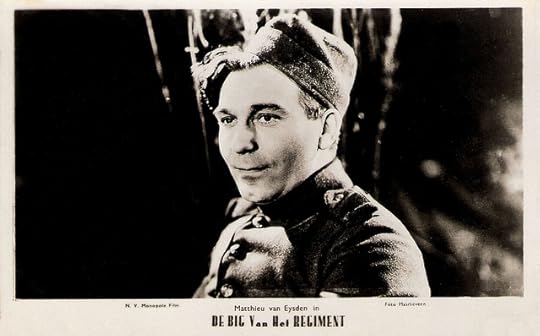
Dutch vintage postcard by Monopole Film NV. Photo: Maarseveen. Still for De Big van het Regiment (1935, Max Nosseck). Collection: Egbert Barten.
The Bluejackets
Matthieu van Eysden was born Mattheus Marinus van Eijsden in Amersfoort, the Netherlands in 1896. He was the son of musician Mattheus Marinus van Eijsden and Bertha Elisabeth van Kempen.
His parents wanted him to follow a training as an officer. He was a sergeant and served in 1914-1918 during WW I. He joined an amateur theatre association and earned his living in the car trade.
In 1920 author and director Herman Heijermans admitted him to his stage company Tooneelvereeniging and he made his debut in Marie Antoinette. It was the beginning of a long acting career in which he was seen frequently in films as well as on stage.
On stage he played mainly revue, musical and operetta. One of his first films was the silent version of Herman Bouber’s hit play De jantjes/The Bluejackets (Maurits Binger, B. E. Doxat-Pratt, 1922) with Beppie de Vries, Johan Elsensohn and Louis Davids.
He also appeared in the silent Dutch comedies Moderne landhaaien/Modern Land Sharks (Alex Benno, 1926) with Maurits de Vries, and Artistenrevue/Artists Revue (Alex Benno, 1926) with Alex de Meester and Isodoor Zwaaf.
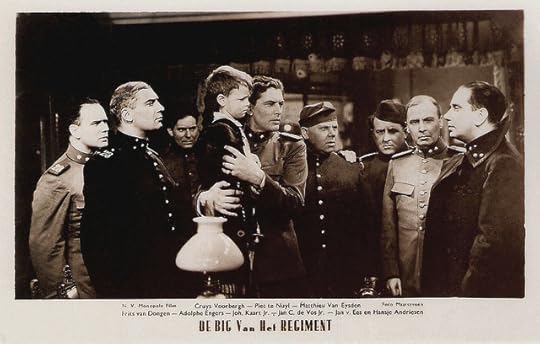
Dutch vintage postcard by Monopole Film NV. Photo: Maarseveen. Still for De Big van het Regiment (1935, Max Nosseck) with Frits van Dongen , Cruys Voorbergh, Matthieu van Eysden, Adolphe Engers , and Johan Kaart . Collection: Egbert Barten.
Douglas Sirk and Max Ophüls
During the 1930s, Matthieu van Eysden appeared in supporting parts in several Dutch sound films. In Het meisje met den blauwen hoed/The Girl with the blue hat (Rudolf Meinert, 1934), he supported Truus van Aalten , Roland Varno and Lou Bandy .
That year he also played in the drama Op hoop van zegen/The Good Hope (Alex Benno, 1934) after the 1900 play by the same name by Herman Heijermans. He had another supporting role in the comedy De Big van het Regiment/The Regiment's Mascot (Max Nosseck, 1935), a First World War farce about the mobilization of the Dutch Army starring Frits van Dongen aka Philip Dorn.
German director Detlev Sierck, later better known as Douglas Sirk directed him in the comedy 't was een april (Detlev Sierck, Jacques van Tol, 1936), an alternate-language version of the German Ufa production April, April! (Detlev Sierck, 1935).
Van Eysden had also small parts in Rubber (Gerard Rutten, Johan de Meester, 1936), the only Dutch fictional film made in the colonial Indonesia (Dutch India), and in Merijntje Gijzen's Jeugd/The Youth of Merijntje Gijzen (Kurt Gerron, 1936) about the hard life of Dutch villagers around 1900 in the southern part of the Netherlands.
Van Eysden had one of his biggest roles opposite Herman Bouber in Komedie om Geld/The Trouble With Money (1936), a biting comedy about financial fraud directed by German Max Ophüls. At the time, the film was the most expensive production ever to have been made in the Netherlands costing around 150,000 guilders. On its initial release, it only took around 10,000 guilders at the box office.
Another flop was Kermisgasten/Fair People (Jaap Speyer, 1936) starring Henriëtte Davids and Johan Kaart . Then followed a huge success with Pygmalion (Ludwig Berger, 1937), the Dutch film version of the play by George Bernard Shaw. Lily Bouwmeester played the Dutch Eliza Doolittle and Van Eysden was her father. He also appeared with Bouwmeester in Veertig Jaren/Forty Years (Johan De Meester, Edmond T. Gréville, 1938).

Dutch postcard by Monopole Film N.V. Photo: Dick van Maarseveen. Still for De Big van het Regiment (1935, Max Nosseck) with Johan Kaart , Sylvaïn Poons , Hansje Andriesen, Matthieu van Eysden, and Adolphe Engers . Collection: Egbert Barten.
But Not In Vain
In 1940, Matthieu van Eysden played in another film starring Lily Bouwmeester, Ergens in Nederland/Somewhere in the Netherlands (Ludwig Berger, 1940). It was the last pre-war film. Ergens in Nederland was just ready for release when the Netherlands were conquered by the Nazis, who forbade its exhibition.
During WWII, Van Eysden appeared in the comedy Drie Weken Huisknecht/Three weeks servant (Walter Smith, 1944) opposite Paul Steenbergen. This was the only Dutch feature film which was completed during the war.
After the war Van Eysden appeared in the Anglo-Dutch World War II drama Niet Tevergeefs/But Not in Vain (Edmond T. Gréville, 1948) starring Raymond Lovell. The film is set in 1944 in the occupied Netherlands, and was shot at the Cinetone Studios in Amsterdam, with exterior filming taking place at locations in and around the city. The film also incorporates authentic wartime footage filmed by members of the Dutch Resistance.
The Dutch version of the film was the first Dutch production of a feature film after World War II. The film's name is derived from a wartime radio speech by the exiled Queen Wilhelmina of the Netherlands, exhorting her people to resist the Nazi occupation and promising that their struggle and sacrifice would not be in vain. The film is ‘missing, believed lost’.
His final feature film was the comedy Een koninkrijk voor een huis/A Kingdom for a House (Jaap Speyer, 1949), about the post-war problem of the lack of living quarters. He later often appeared on television, like in the TV series Maigret (1967) featuring Jan Teulings, and finally in Op straffe des doods/Under penalty of death (Rob van der Linden, 1970) starring Kees Brusse.
Matthieu van Eysden died in Haarlem (according to IMDb in Rotterdam) in 1970. He was 74. He was married to revue and operetta actress Maria Margaretha ‘Mary’van den Berg (1932-1949). They had a daughter, Dolores Mia.
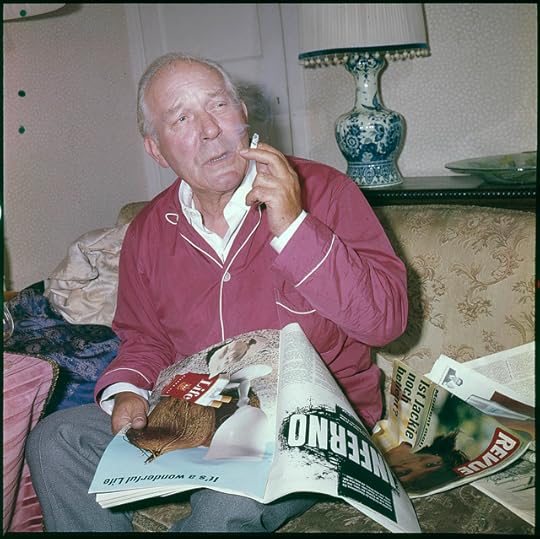
Matthieu van Eijsden, 1963. Photo: Ben van Meerendonk / AHF. Collection: IISG, Amsterdam (Flickr).
Sources: Theaterencyclopedie.nl, Genealogieonline, Wikipedia (English and Dutch), and .

Dutch vintage postcard by Monopole Film NV. Photo: Maarseveen. Still for De Big van het Regiment (1935, Max Nosseck). Collection: Egbert Barten.
The Bluejackets
Matthieu van Eysden was born Mattheus Marinus van Eijsden in Amersfoort, the Netherlands in 1896. He was the son of musician Mattheus Marinus van Eijsden and Bertha Elisabeth van Kempen.
His parents wanted him to follow a training as an officer. He was a sergeant and served in 1914-1918 during WW I. He joined an amateur theatre association and earned his living in the car trade.
In 1920 author and director Herman Heijermans admitted him to his stage company Tooneelvereeniging and he made his debut in Marie Antoinette. It was the beginning of a long acting career in which he was seen frequently in films as well as on stage.
On stage he played mainly revue, musical and operetta. One of his first films was the silent version of Herman Bouber’s hit play De jantjes/The Bluejackets (Maurits Binger, B. E. Doxat-Pratt, 1922) with Beppie de Vries, Johan Elsensohn and Louis Davids.
He also appeared in the silent Dutch comedies Moderne landhaaien/Modern Land Sharks (Alex Benno, 1926) with Maurits de Vries, and Artistenrevue/Artists Revue (Alex Benno, 1926) with Alex de Meester and Isodoor Zwaaf.

Dutch vintage postcard by Monopole Film NV. Photo: Maarseveen. Still for De Big van het Regiment (1935, Max Nosseck) with Frits van Dongen , Cruys Voorbergh, Matthieu van Eysden, Adolphe Engers , and Johan Kaart . Collection: Egbert Barten.
Douglas Sirk and Max Ophüls
During the 1930s, Matthieu van Eysden appeared in supporting parts in several Dutch sound films. In Het meisje met den blauwen hoed/The Girl with the blue hat (Rudolf Meinert, 1934), he supported Truus van Aalten , Roland Varno and Lou Bandy .
That year he also played in the drama Op hoop van zegen/The Good Hope (Alex Benno, 1934) after the 1900 play by the same name by Herman Heijermans. He had another supporting role in the comedy De Big van het Regiment/The Regiment's Mascot (Max Nosseck, 1935), a First World War farce about the mobilization of the Dutch Army starring Frits van Dongen aka Philip Dorn.
German director Detlev Sierck, later better known as Douglas Sirk directed him in the comedy 't was een april (Detlev Sierck, Jacques van Tol, 1936), an alternate-language version of the German Ufa production April, April! (Detlev Sierck, 1935).
Van Eysden had also small parts in Rubber (Gerard Rutten, Johan de Meester, 1936), the only Dutch fictional film made in the colonial Indonesia (Dutch India), and in Merijntje Gijzen's Jeugd/The Youth of Merijntje Gijzen (Kurt Gerron, 1936) about the hard life of Dutch villagers around 1900 in the southern part of the Netherlands.
Van Eysden had one of his biggest roles opposite Herman Bouber in Komedie om Geld/The Trouble With Money (1936), a biting comedy about financial fraud directed by German Max Ophüls. At the time, the film was the most expensive production ever to have been made in the Netherlands costing around 150,000 guilders. On its initial release, it only took around 10,000 guilders at the box office.
Another flop was Kermisgasten/Fair People (Jaap Speyer, 1936) starring Henriëtte Davids and Johan Kaart . Then followed a huge success with Pygmalion (Ludwig Berger, 1937), the Dutch film version of the play by George Bernard Shaw. Lily Bouwmeester played the Dutch Eliza Doolittle and Van Eysden was her father. He also appeared with Bouwmeester in Veertig Jaren/Forty Years (Johan De Meester, Edmond T. Gréville, 1938).

Dutch postcard by Monopole Film N.V. Photo: Dick van Maarseveen. Still for De Big van het Regiment (1935, Max Nosseck) with Johan Kaart , Sylvaïn Poons , Hansje Andriesen, Matthieu van Eysden, and Adolphe Engers . Collection: Egbert Barten.
But Not In Vain
In 1940, Matthieu van Eysden played in another film starring Lily Bouwmeester, Ergens in Nederland/Somewhere in the Netherlands (Ludwig Berger, 1940). It was the last pre-war film. Ergens in Nederland was just ready for release when the Netherlands were conquered by the Nazis, who forbade its exhibition.
During WWII, Van Eysden appeared in the comedy Drie Weken Huisknecht/Three weeks servant (Walter Smith, 1944) opposite Paul Steenbergen. This was the only Dutch feature film which was completed during the war.
After the war Van Eysden appeared in the Anglo-Dutch World War II drama Niet Tevergeefs/But Not in Vain (Edmond T. Gréville, 1948) starring Raymond Lovell. The film is set in 1944 in the occupied Netherlands, and was shot at the Cinetone Studios in Amsterdam, with exterior filming taking place at locations in and around the city. The film also incorporates authentic wartime footage filmed by members of the Dutch Resistance.
The Dutch version of the film was the first Dutch production of a feature film after World War II. The film's name is derived from a wartime radio speech by the exiled Queen Wilhelmina of the Netherlands, exhorting her people to resist the Nazi occupation and promising that their struggle and sacrifice would not be in vain. The film is ‘missing, believed lost’.
His final feature film was the comedy Een koninkrijk voor een huis/A Kingdom for a House (Jaap Speyer, 1949), about the post-war problem of the lack of living quarters. He later often appeared on television, like in the TV series Maigret (1967) featuring Jan Teulings, and finally in Op straffe des doods/Under penalty of death (Rob van der Linden, 1970) starring Kees Brusse.
Matthieu van Eysden died in Haarlem (according to IMDb in Rotterdam) in 1970. He was 74. He was married to revue and operetta actress Maria Margaretha ‘Mary’van den Berg (1932-1949). They had a daughter, Dolores Mia.

Matthieu van Eijsden, 1963. Photo: Ben van Meerendonk / AHF. Collection: IISG, Amsterdam (Flickr).
Sources: Theaterencyclopedie.nl, Genealogieonline, Wikipedia (English and Dutch), and .
Published on October 30, 2013 00:00
October 29, 2013
Juana Borguèse
Very little is known about Juana Borguèse who played the evil Baronne d'Apremont in the French silent serial La nouvelle mission de Judex/The New Mission of Judex (1917-1918).
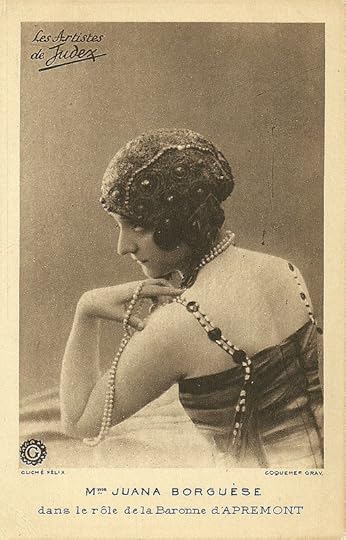
French postcard by Coquemer Gravures, Paris. Photo: Félix / Gaumont. Still for La nouvelle mission de Judex (1917-1918).
Creating Havoc In Tandem
Was Juana Borguèse a pseudonym? We don't know, no where and when she was born.
Together with another mysterious and dangerous woman, Gaby (Cyprien Giles), Borguèse's Baronne 'creates havoc in tandem', as Vicki Calahan writes in Zones of Anxiety: Movement, Musidora, and the Crime Serials of Louis Feuillade.
Baronne d'Apremont is the accomplice of the evil Dr. Howey (Andrew Brunelle) in La nouvelle mission de Judex/The New Mission of Judex (Louis Feuillade, 1917-1918).
She has hypnotic powers - mark the eyes on the card - enabling her to force the innocent to do things against their will.
According to Cineressources , the site of the Cinémathèque française, she also played an uncredited part in the earlier film Judex (Louis Feuillade, 1916) in which Musidora played the scheming villain Diana Monti.
Who can tell us more about Juana Borguèse?
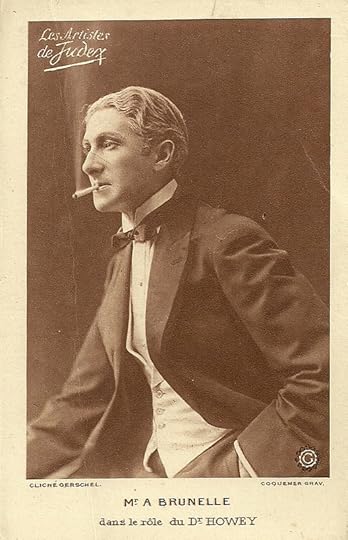
Andrew Brunelle. French postcard by Coquemer Gravures, Paris. Photo: Gerschel / Gaumont. Still for La nouvelle mission de Judex (1917-1918).
Sources: Vicki Callahan (Zones of Anxiety: Movement, Musidora and the Crime Serals of Louis Feuillade), Cineressources and

French postcard by Coquemer Gravures, Paris. Photo: Félix / Gaumont. Still for La nouvelle mission de Judex (1917-1918).
Creating Havoc In Tandem
Was Juana Borguèse a pseudonym? We don't know, no where and when she was born.
Together with another mysterious and dangerous woman, Gaby (Cyprien Giles), Borguèse's Baronne 'creates havoc in tandem', as Vicki Calahan writes in Zones of Anxiety: Movement, Musidora, and the Crime Serials of Louis Feuillade.
Baronne d'Apremont is the accomplice of the evil Dr. Howey (Andrew Brunelle) in La nouvelle mission de Judex/The New Mission of Judex (Louis Feuillade, 1917-1918).
She has hypnotic powers - mark the eyes on the card - enabling her to force the innocent to do things against their will.
According to Cineressources , the site of the Cinémathèque française, she also played an uncredited part in the earlier film Judex (Louis Feuillade, 1916) in which Musidora played the scheming villain Diana Monti.
Who can tell us more about Juana Borguèse?

Andrew Brunelle. French postcard by Coquemer Gravures, Paris. Photo: Gerschel / Gaumont. Still for La nouvelle mission de Judex (1917-1918).
Sources: Vicki Callahan (Zones of Anxiety: Movement, Musidora and the Crime Serals of Louis Feuillade), Cineressources and
Published on October 29, 2013 00:00
October 28, 2013
Happy birthday, Cornelia Froboess!
Today Die Connie has her 70th birthday! German singer an actress Cornelia 'Conny' Froboess (1943) started her career 62 years ago with the cheery song Pack die Badehose ein (1951, Pack Your Swimsuit). In the late 1950s and early 1960s, she became an immensely popular teen idol as a spontaneous Berliner Göre (brat from Berlin) in Schlager films with Peter Kraus and Rex Gildo. She also represented West-Germany at the 1962 Eurovision Song Contest. In the 1970s, she transformed into a respected stage actress and in the following decades she appeared in such major films as Rainer Werner Fassbinder’s Die Sehnsucht der Veronika Voss/Veronika Voss (1982) and Knockin' on Heaven's Door (Thomas Jahn, 1997), playing the mother of Til Schweiger. Herzlichen Glückwunsch zum Geburtstag, Conny!

German postcard by WS-Druck, Wanne-Eickel. Photo: Schönbrunn / Constantin-Film.
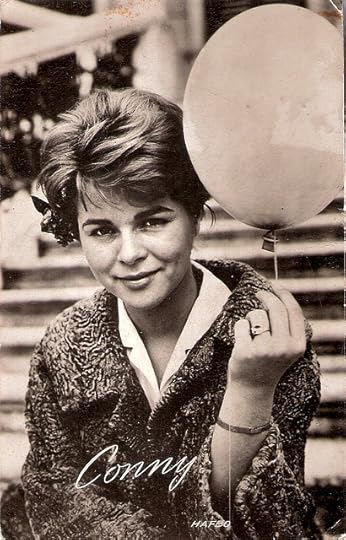
Dutch postcard by Takken, Utrecht, no. AX 4773. Photo: HAFBO.

Vintage card, with far left Rex Gildo .
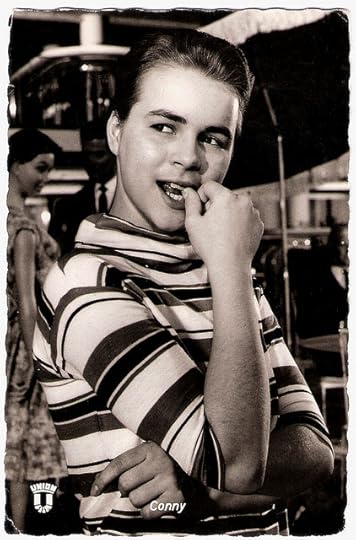
German postcard by Kolibri Verlag, Minden. Photo: H.P. / Union / Ewald. Publicity still for the musical comedy Hula-Hopp, Conny (1958).
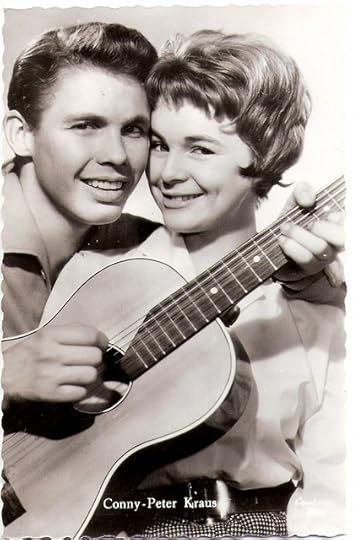
Dutch postcard, no. 761, with Peter Kraus .

German postcard by WS-Druck, Wanne-Eickel. Photo: Schönbrunn / Constantin-Film.

Dutch postcard by Takken, Utrecht, no. AX 4773. Photo: HAFBO.

Vintage card, with far left Rex Gildo .

German postcard by Kolibri Verlag, Minden. Photo: H.P. / Union / Ewald. Publicity still for the musical comedy Hula-Hopp, Conny (1958).

Dutch postcard, no. 761, with Peter Kraus .
Published on October 28, 2013 00:00
October 27, 2013
Aliki Vouyouklaki
Blonde, dark-eyed Aliki Vouyouklaki (Greek: Αλίκη Βουγιουκλάκη) (1934-1996) was one of the most popular and successful actresses of the Greek cinema. She appeared in 42 films, mostly comedies and musicals, and in a wide variety of television programs, theatre and stage productions.
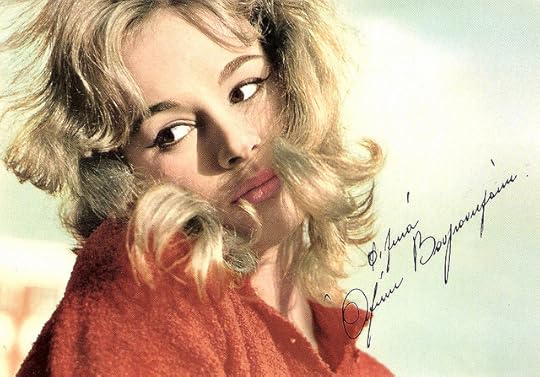
Italian postcard by Select, no. 202. Photo: Giovanni Trimboli.
Eliza Doolittle
Aliki Stamatina Vouyouklaki (also written as Vuyuklaki or Vougiouklaki) was born in Maroussi, Greece, in 1933 (or 1934, according to some sources). She had two brothers, film director Takis Vouyouklakis, and architect Antonis Vouyouklakis. Her father was killed by German troops during World War II.
She studied at the Drama School of the Greek National Theater and she started to act while still a student. Aliki made her stage debut in a 1953 Athens production of Molière's Le malade imaginaire (The Imaginary Patient).
Around the same time she made her first film, playing the leading role in To pontikaki/The little Mouse (Yorgos Assimakopoulos, Nikos Tsiforos, 1954), the Greek version of My Fair Lady. This debut would be followed by scores of other popular dramatic and comic films.
The late 1950's was her breakthrough period: on stage she starred as Eliza Doolittle in a successful 1958 revival of George Bernard Shaw's Pygmalion (the play on which My Fair Lady was based) and she took the leading part in a very popular film, To xylo vgike apo ton Paradeiso/Maiden's Cheek (Alekos Sakellarios, 1959).
Instantly, Aliki with her classical beauty became Greece's most popular star. A doll and a pastry were named after her. She featured in several films for production company Finos films during the ‘golden age of the commercial Greek cinema’; the early 1960s. Her trademark was a red hibiscus behind her ear.
She also created her personal theatre group and staged plays like Tennessee Williams' Sweet Bird of Youth. She starred in Aristophanes' Lysistrata and Sophocles' Antigone in the ancient theatre of Epidaurus, both productions were massive commercial successes, but created great controversies.
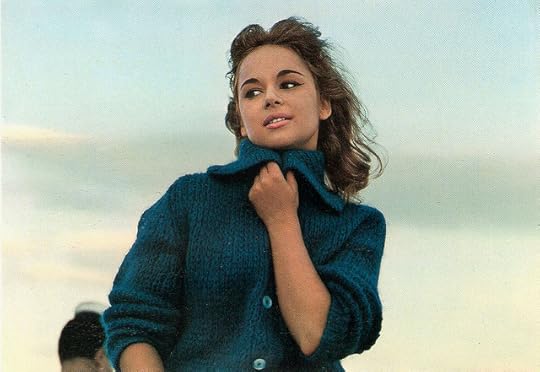
Italian postcard by Select, no. 201. Photo: Giovanni Trimboli.
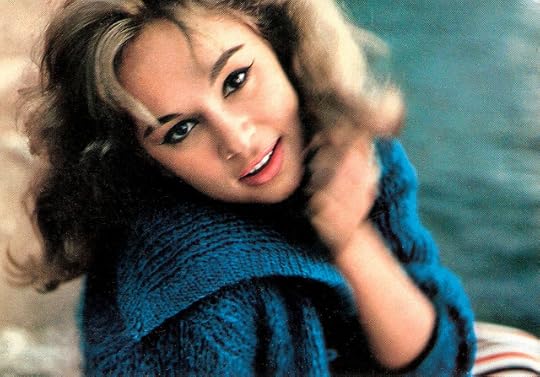
Italian postcard by Select, no. 205. Photo: Giovanni Trimboli.
A Total Flop
Aliki Vouyouklaki won the Best Actress prize at the first Thessaloniki Film Festival in 1960 for her starring role in Madalena (Dinos Dimopoulos, 1960).
In 1965 she married her film and stage partner Dimitris Papamichail. They had met on the set as the leads of the romantic comedy To xylo vgike apo ton Paradeiso/Maiden's Cheek (1959) and had also fallen in love privately. Together, they went on to star in a number of popular films, includingI Aliki sto Naftiko/Aliki in the Navy (Alekos Sakellarios, 1961), which sold more than 590,000 tickets in Greece.
Alekos Sakellarios wrote the biggest comedy hits of the Greek cinema, and Aliki acted in them, singing the unforgettable songs of composer Manos Hatzidakis. Aliki herself allegedly wrote the script for the English language production, Aliki my love (Rudolph Maté, 1962) co-starring Wilfred Hyde-White. The film premiered both in London and Athens, but was a total flop.
While she was best-known in her native land, Vouyouklaki also had followings in Israel and Turkey. The film Htypokardia sto thranio/Heartbeats in High School (Alekos Sakellarios, 1963) was shot simultaneously in Greek and Turkish, with two different casts. Aliki starred in both versions, with her voice being dubbed in the Turkish version, Siralardaki heyecanlar (Alekos Sakellarios, 1963).
I neraida kai to palikari/The Fairy and the Man (Dinos Dimopoulos, 1969) was a comic version of William Shakespeare's Romeo and Juliet. In 1969, Aliki also gave birth to her only child, Yiannis Papamichail.
The following year came her biggest success with the film Ypolohagos Natassa/Battlefield Constantinople (Nikos Foskolos, 1970), about a young Greek woman who lost her husband during the Second World War. The film sold more than 750,000 tickets in Athens, and would stay the biggest moneymaker in the history of Greek cinema for almost three decades.
In 1970 she received the title, National Star of Greece. I Maria tis siopis/Maria of silence (Giannis Dalianidis, 1973) was a remake of the Hollywood production Johnny Belinda (Jean Negulesco, 1948) about a deaf and mute rape victim, originally played by Jane Wyman.
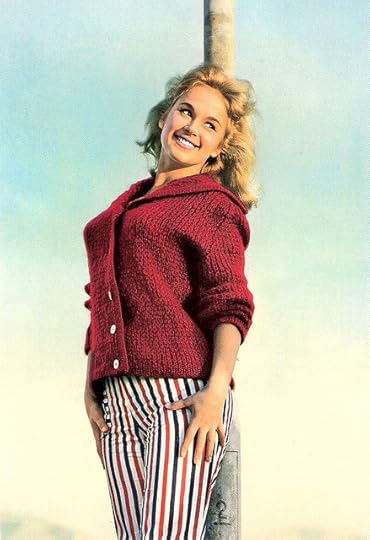
Italian postcard by Select, no. 206. Photo: Giovanni Trimboli.
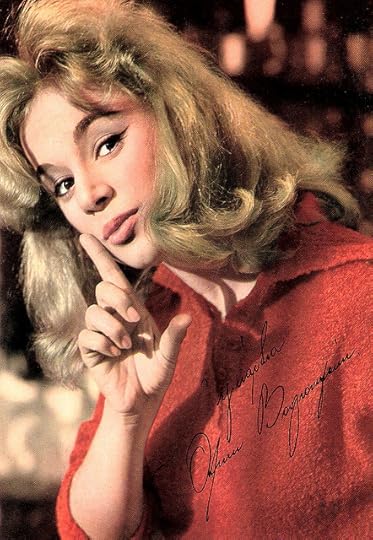
Italian postcard by Select, no. 203. Photo: Giovanni Trimboli.
I Have A Secret
Eventually Aliki Vouyouklaki‘s marriage to Dimitris Papamichail became troubled. She shot her next film S'Agapo/I love you (Takis Vougiouklakis, 1971) without her husband and regular co-star, and the celebrity couple divorced in 1975.
Aliki continued to play in the theatre. Since 1971 she owned her own theatre, named Aliki. It staged one hit after another, among them Cabaret, My Fair Lady, and Educating Rita. Even though she was the number one box office star in Greece, Aliki went through an audition in London in order to get the rights to play the title part in the Rice-Webber musical Evita. About her portrayal of Eva Perón, Laurence Olivier later was quoted: "the best Evita I have ever seen".
After a seven year absence, she made her comeback at the silver screen in Poniro thilyko... katergara gynaika!/A cunning woman (Kostas Karagiannis, 1980), based on the W. Somerset Maugham play.
Her final film, Kataskopos Nelli (1981, Takis Vouyouklakis), was a strange mixture of two of her biggest theatrical hits, Cabaret and Evita. Shooting began in 1979 and the film was to be called The Girl At The Cabaret, but due to copyright problems (she was not granted permission to use the original songs of the musical) the project was shelved. Shooting was resumed in 1980 with a different storyline and new songs and the film was released in 1981.
Aliki would make only stage and TV appearances thereafter. She worked with playwright Willy Russell when she performed in his play Shirley Valentine in 1989. The last year of her life she starred in I melodia tis eftyhias (The Sound of Music), disregarding critics that thought that she was too old for the role of Maria. The musical was another box office smash and it was also filmed for TV.
Aliki Vouyouklaki died in 1996 in Athens from pancreatic cancer. Her funeral was attended by thousands of her fans. She was married twice, to Dimitris Papamichail (1965-1975) and to Giorgos Iliadis (1979-1980). In 2008, her son Yiannis Papamichail published a biography of his mother, Eho Ena Mistiko (I Have A Secret), which was also the title of a song the idol sang in her success film To Xilo Vgike apo to Paradiso (1959). In 2008 a television series based on the book, aired on Alpha TV channel.
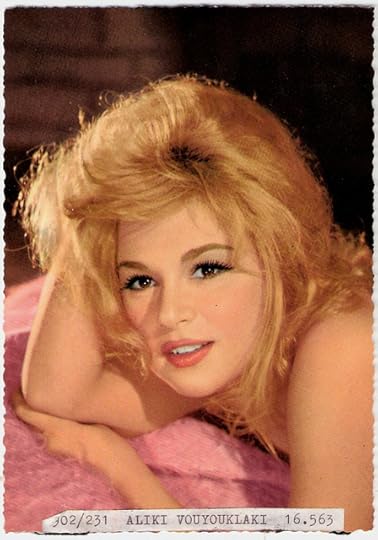
German postcard by Krüger, no. 902/231.
Aliki Vouyouklaki sings Thalassa platia in Madalena (1960). Source: outis27 (YouTube).
Aliki Vouyouklaki sings Katerina. Source: Chrysw M (YouTube).
Sources: (IMDb), Sandra Brennan (AllMovie), Antenna News, Wikipedia, and .

Italian postcard by Select, no. 202. Photo: Giovanni Trimboli.
Eliza Doolittle
Aliki Stamatina Vouyouklaki (also written as Vuyuklaki or Vougiouklaki) was born in Maroussi, Greece, in 1933 (or 1934, according to some sources). She had two brothers, film director Takis Vouyouklakis, and architect Antonis Vouyouklakis. Her father was killed by German troops during World War II.
She studied at the Drama School of the Greek National Theater and she started to act while still a student. Aliki made her stage debut in a 1953 Athens production of Molière's Le malade imaginaire (The Imaginary Patient).
Around the same time she made her first film, playing the leading role in To pontikaki/The little Mouse (Yorgos Assimakopoulos, Nikos Tsiforos, 1954), the Greek version of My Fair Lady. This debut would be followed by scores of other popular dramatic and comic films.
The late 1950's was her breakthrough period: on stage she starred as Eliza Doolittle in a successful 1958 revival of George Bernard Shaw's Pygmalion (the play on which My Fair Lady was based) and she took the leading part in a very popular film, To xylo vgike apo ton Paradeiso/Maiden's Cheek (Alekos Sakellarios, 1959).
Instantly, Aliki with her classical beauty became Greece's most popular star. A doll and a pastry were named after her. She featured in several films for production company Finos films during the ‘golden age of the commercial Greek cinema’; the early 1960s. Her trademark was a red hibiscus behind her ear.
She also created her personal theatre group and staged plays like Tennessee Williams' Sweet Bird of Youth. She starred in Aristophanes' Lysistrata and Sophocles' Antigone in the ancient theatre of Epidaurus, both productions were massive commercial successes, but created great controversies.

Italian postcard by Select, no. 201. Photo: Giovanni Trimboli.

Italian postcard by Select, no. 205. Photo: Giovanni Trimboli.
A Total Flop
Aliki Vouyouklaki won the Best Actress prize at the first Thessaloniki Film Festival in 1960 for her starring role in Madalena (Dinos Dimopoulos, 1960).
In 1965 she married her film and stage partner Dimitris Papamichail. They had met on the set as the leads of the romantic comedy To xylo vgike apo ton Paradeiso/Maiden's Cheek (1959) and had also fallen in love privately. Together, they went on to star in a number of popular films, includingI Aliki sto Naftiko/Aliki in the Navy (Alekos Sakellarios, 1961), which sold more than 590,000 tickets in Greece.
Alekos Sakellarios wrote the biggest comedy hits of the Greek cinema, and Aliki acted in them, singing the unforgettable songs of composer Manos Hatzidakis. Aliki herself allegedly wrote the script for the English language production, Aliki my love (Rudolph Maté, 1962) co-starring Wilfred Hyde-White. The film premiered both in London and Athens, but was a total flop.
While she was best-known in her native land, Vouyouklaki also had followings in Israel and Turkey. The film Htypokardia sto thranio/Heartbeats in High School (Alekos Sakellarios, 1963) was shot simultaneously in Greek and Turkish, with two different casts. Aliki starred in both versions, with her voice being dubbed in the Turkish version, Siralardaki heyecanlar (Alekos Sakellarios, 1963).
I neraida kai to palikari/The Fairy and the Man (Dinos Dimopoulos, 1969) was a comic version of William Shakespeare's Romeo and Juliet. In 1969, Aliki also gave birth to her only child, Yiannis Papamichail.
The following year came her biggest success with the film Ypolohagos Natassa/Battlefield Constantinople (Nikos Foskolos, 1970), about a young Greek woman who lost her husband during the Second World War. The film sold more than 750,000 tickets in Athens, and would stay the biggest moneymaker in the history of Greek cinema for almost three decades.
In 1970 she received the title, National Star of Greece. I Maria tis siopis/Maria of silence (Giannis Dalianidis, 1973) was a remake of the Hollywood production Johnny Belinda (Jean Negulesco, 1948) about a deaf and mute rape victim, originally played by Jane Wyman.

Italian postcard by Select, no. 206. Photo: Giovanni Trimboli.

Italian postcard by Select, no. 203. Photo: Giovanni Trimboli.
I Have A Secret
Eventually Aliki Vouyouklaki‘s marriage to Dimitris Papamichail became troubled. She shot her next film S'Agapo/I love you (Takis Vougiouklakis, 1971) without her husband and regular co-star, and the celebrity couple divorced in 1975.
Aliki continued to play in the theatre. Since 1971 she owned her own theatre, named Aliki. It staged one hit after another, among them Cabaret, My Fair Lady, and Educating Rita. Even though she was the number one box office star in Greece, Aliki went through an audition in London in order to get the rights to play the title part in the Rice-Webber musical Evita. About her portrayal of Eva Perón, Laurence Olivier later was quoted: "the best Evita I have ever seen".
After a seven year absence, she made her comeback at the silver screen in Poniro thilyko... katergara gynaika!/A cunning woman (Kostas Karagiannis, 1980), based on the W. Somerset Maugham play.
Her final film, Kataskopos Nelli (1981, Takis Vouyouklakis), was a strange mixture of two of her biggest theatrical hits, Cabaret and Evita. Shooting began in 1979 and the film was to be called The Girl At The Cabaret, but due to copyright problems (she was not granted permission to use the original songs of the musical) the project was shelved. Shooting was resumed in 1980 with a different storyline and new songs and the film was released in 1981.
Aliki would make only stage and TV appearances thereafter. She worked with playwright Willy Russell when she performed in his play Shirley Valentine in 1989. The last year of her life she starred in I melodia tis eftyhias (The Sound of Music), disregarding critics that thought that she was too old for the role of Maria. The musical was another box office smash and it was also filmed for TV.
Aliki Vouyouklaki died in 1996 in Athens from pancreatic cancer. Her funeral was attended by thousands of her fans. She was married twice, to Dimitris Papamichail (1965-1975) and to Giorgos Iliadis (1979-1980). In 2008, her son Yiannis Papamichail published a biography of his mother, Eho Ena Mistiko (I Have A Secret), which was also the title of a song the idol sang in her success film To Xilo Vgike apo to Paradiso (1959). In 2008 a television series based on the book, aired on Alpha TV channel.

German postcard by Krüger, no. 902/231.
Aliki Vouyouklaki sings Thalassa platia in Madalena (1960). Source: outis27 (YouTube).
Aliki Vouyouklaki sings Katerina. Source: Chrysw M (YouTube).
Sources: (IMDb), Sandra Brennan (AllMovie), Antenna News, Wikipedia, and .
Published on October 27, 2013 00:00
October 25, 2013
Imported from the USA: Clint Eastwood
American film actor and director Clint Eastwood (1930) rose to fame as the Man with No Name in Sergio Leone's classic Spaghetti Westerns Per un pugno di dollari/A Fistful of Dollars (1964), Per qualche dollaro in più/For a Few Dollars More (1965), and Il buono, il brutto, il cattivo/The Good, the Bad and the Ugly (1966). Later in the US, he played hard edge police inspector Harry Callahan in the five Dirty Harry films, which elevated him to superstar status, and he directed and produced such award-winning masterpieces as Unforgiven (1992), Mystic River (2003) and Million Dollar Baby (2004).
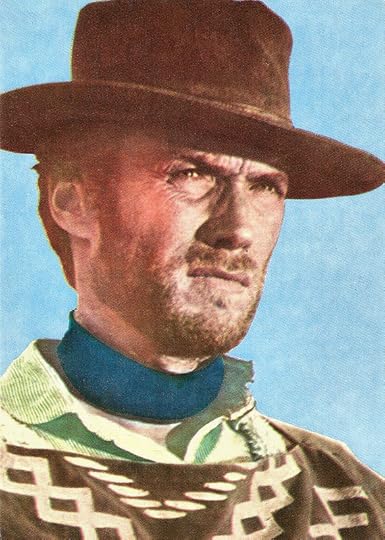
Romanian postcard by Colectia Cinefilului Acin.
Towering Height And Slender Frame
Clinton ‘Clint’ Eastwood, Jr. was born in San Francisco, California in 1930. His parents were Clinton Eastwood, Sr., a steelworker and migrant worker, and Margaret Ruth (Runner) Eastwood, a factory worker. Clint has a younger sister, Jeanne. Because of his father's difficulty in finding steady work during the depression, Eastwood moved with his family from one Northern California town to another, attending some eight elementary schools in the process.
Later he had odd jobs as a fire-fighter and lumberjack in Oregon, as well as a steelworker in Seattle. In 1951, Eastwood was drafted into the US Army, where he was a swimming instructor during the Korean War. He briefly attended Los Angeles City College but dropped out to pursue acting.
Eastwood married Maggie Johnson in 1953, six months after they met on a blind date. However, their matrimony would not prove altogether smooth, with Eastwood believing that he had married too early.
In 1954, the good-looking Eastwood with his towering height and slender frame got a contract at Universal. At first, he was criticized for his stiff manner, his squint, and for hissing his lines through his teeth. His first acting role was an uncredited bit part as a laboratory assistant in the Sci-Fi horror film Revenge of the Creature (Jack Arnold, 1955).
Over the next three years, he more bit parts in such films as Lady Godiva of Coventry (Arthur Lubin, 1955), Tarantula (Jack Arnold, 1955), and the war drama Away All Boats (Joseph Pevney, 1956) with George Nader and Lex Barker .
His first bigger roles were in the B-Western Ambush at Cimarron Pass (Jodie Copelan, 1958), and the war film Lafayette Escadrille (William A. Wellman, 1958), starring Tab Hunter and Etchika Choureau .
In 1959, he became a TV star as Rowdy Yates in the Western series Rawhide (1959–1966). Although Rawhide never won an Emmy, it was a ratings success for several years.
During a trial separation from Maggie Johnson, an affair with dancer Roxanne Tunis produced Eastwood’s first child, Kimber Tunis (1964). An intensely private person, Clint Eastwood was rarely featured in the tabloid press. However, he had more affairs, e.g. with actresses Catherine Deneuve , Inger Stevens and Jean Seberg. After a reconciliation, he had two children with Johnson: Kyle Eastwood (1968) and Alison Eastwood (1972), though he was not present at either birth. Johnson filed for legal separation in 1978, but the pair officially divorced in 1984.
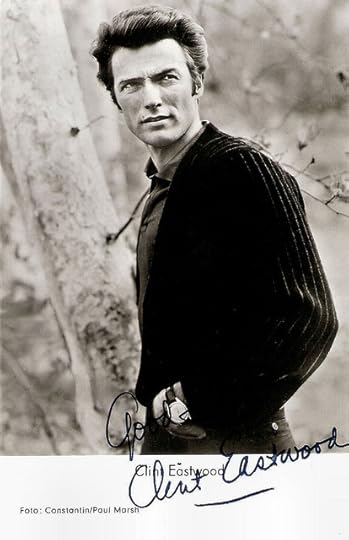
German postcard. Photo: Constantin / Paul March.
The Man With No Name Trilogy
In late 1963, Clint Eastwood's Rawhide co-star Eric Fleming rejected an offer to star in an Italian-made Western. Eastwood, who in turn saw the film as an opportunity to escape from his Rawhide image, signed the contract.
The Western was called Per un pugno di dollari/A Fistful of Dollars (1964), to be directed in a remote region of Spain by the then relatively unknown Sergio Leone. A Fistful of Dollars, also with Gian Maria Volonté and Marianne Koch , was a remake of Akira Kurosawa's Yojimbo (1961).
Eastwood played a cynical gunfighter who comes to a small border town, torn apart by two feuding families. Hiring himself out as a mercenary, the lone drifter plays one side against the other until nothing remains of either side. Eastwood started to develop a minimalist acting style and created the character's distinctive visual style. Although a non-smoker, Leone insisted Eastwood smoke cigars as an essential ingredient of the ‘mask’ he was attempting to create for the loner character.
Per un pugno di dollari/A Fistful of Dollars (Sergio Leone, 1964) was the first instalment of the Dollars trilogy. Later, United Artists, who distributed it in the US, coined another term for it: the Man With No Name trilogy. ‘The second part was Per qualche dollaro in più/For a Few Dollars More (Sergio Leone, 1965), a richer, more mythologized film that focused on two ruthless bounty hunters (Eastwood and Lee Van Cleef) who form a tenuous partnership to hunt down a wanted bandit (Gian Maria Volontè). Both films were a huge success in Italy. They both contain all of Leone's eventual trademarks: taciturn characters, precise framing, extreme close-ups, and the haunting music of Ennio Morricone.
Eastwood also appeared in a segment of Dino De Laurentiis’ five-part anthology production Le Streghe/The Witches ( Vittorio De Sica a.o., 1967). But his performance opposite De Laurentiis' wife Silvana Mangano did not please the critics.
Eastwood then played in the third and best Dollars film, Il buono, il brutto, il cattivo/The Good, the Bad and the Ugly (Sergio Leone, 1966). Again he played the mysterious Man with No Name, wearing the same trademark poncho (reportedly without ever having washed it). Lee Van Cleef returned as a ruthless fortune seeker, with Eli Wallach portrayed the cunning Mexican bandit Tuco Ramirez.
Yuri German at AllMovie : “Immensely entertaining and beautifully shot in Techniscope by Tonino Delli Colli, the movie is a virtually definitive 'spaghetti western,' rivaled only by Leone's own Once Upon a Time in the West (1968).”
The Dollars trilogy was not released in the United States until 1967, when A Fistful of Dollars opened in January, followed by For a Few Dollars More in May, and The Good, the Bad and the Ugly in December. Eastwood redubbed his own dialogue for the American releases. All the films were commercially successful, particularly The Good, the Bad and the Ugly which turned Eastwood into a major film star. All three films received bad reviews, and marked the beginning of a battle for Eastwood to win American film critics' respect.
According to IMDb , Sergio Leone asked Eastwood, Wallach and Van Cleef to appear again in C'era una volta il West/Once Upon A Time in the West (Sergio Leone, 1968), but they all declined when they heard that their characters were going to be killed off in the first five minutes.
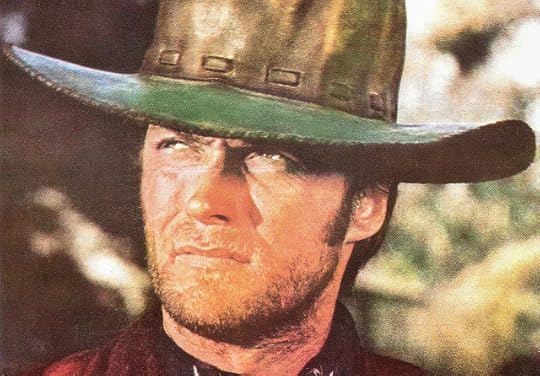
Romanian postcard by Casa Filmului Acin.
Coogan's Bluff
Stardom brought more roles for Clint Eastwood. He signed to star in the American revisionist western Hang 'Em High (Ted Post, 1968), playing a man who takes up a Marshal's badge and seeks revenge as a lawman after being lynched by vigilantes and left for dead.
Using money earned from the Dollars trilogy, accountant and Eastwood advisor Irving Leonard helped establish Eastwood's own production company, Malpaso Productions, named after Malpaso Creek on Eastwood's property in Monterey County, California. Leonard arranged for Hang 'Em High to be a joint production with United Artists. Hang 'Em High was widely praised by critics, and when it opened in July 1968, it had an unprecedented opening weekend in United Artists' history.
His following film was Coogan's Bluff (Don Siegel, 1968), about an Arizona deputy sheriff tracking a wanted psychopathic criminal (Don Stroud) through the streets of New York City. Don Siegel was a Universal contract director who later became Eastwood's close friend, forming a partnership that would last more than ten years and produce five films. Coogan’s Bluff was controversial for its portrayal of violence, Eastwood's role creating the prototype for the macho cop of the Dirty Harry film series. Coogan's Bluff also became the first collaboration with Argentine composer Lalo Schifrin, who would later compose the jazzy score to several Eastwood films in the 1970s and 1980s, including the Dirty Harry films.
Eastwood played the right-hand man of squad's commander Richard Burton in the war epic Where Eagles Dare (Brian G. Hutton, 1968), about a World War II squad parachuting into a Gestapo stronghold in the alpine mountains. Eastwood then branched out to star in the only musical of his career, Paint Your Wagon (Joshua Logan, 1969).
Then, Eastwood starred in the Western Two Mules for Sister Sara (Don Sigel, 1970), with Shirley MacLaine, and as one of a group of Americans who steal a fortune in gold from the Nazis, in the World War II film Kelly's Heroes (Brian G. Hutton, 1970)). Kelly's Heroes was the last film in which Eastwood appeared, that was not produced by his own Malpaso Productions.
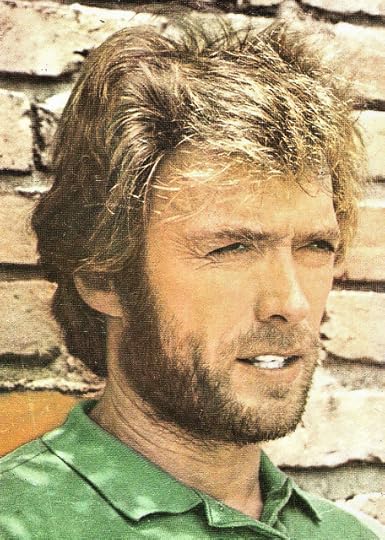
Romanian postcard by Casa Filmului Acin.
Dirty Harry
Clint Eastwood’s next film, The Beguiled (Don Siegel, 1970), was a tale of a wounded Union soldier, held captive by the sexually repressed matron of a southern girl's school. Upon release the film received major recognition in France but in the US it was a box office flop.
Eastwood's career reached a turning point with Dirty Harry (Don Siegel, 1971), The film centres around a hard-edged San Francisco police inspector named Harry Callahan who is determined to stop a psychotic killer by any means. Dirty Harry achieved huge success after its release in December 1971. It was Siegel's highest-grossing film to date and the start of a series of films featuring the character Harry Callahan.
He next starred in the loner Western Joe Kidd (John Sturges, 1972). In 1973, Eastwood directed his first western, High Plains Drifter, in which he starred alongside Verna Bloom. The revisionist film received a mixed reception, but was a major box office success.
Eastwood next turned his attention towards Breezy (Clint Eastwood, 1973), a film about love blossoming between a middle-aged man and a teenage girl. During casting for the film Eastwood met actress Sondra Locke, who would become an important figure in his life.
He reprised his role as Detective Harry Callahan in Magnum Force (Ted Post, 1973). This sequel to Dirty Harry was about a group of rogue young officers (including David Soul and Robert Urich) in the San Francisco Police Force who systematically exterminate the city's worst criminals.
Eastwood teamed up with Jeff Bridges in the buddy action caper Thunderbolt and Lightfoot (Michael Cimino, 1974). Eastwood's acting was noted by critics, but was overshadowed by Bridges who was nominated for an Academy Award for Best Supporting Actor.
His next film The Eiger Sanction (Clint Eastwood, 1975), based on Trevanian's spy novel, was a commercial and critical failure. His next film The Outlaw Josey Wales (Clint Eastwood, 1976) was widely acclaimed, with many critics and viewers seeing Eastwood's role as an iconic one that related to America's ancestral past and the destiny of the nation after the American Civil War.
The third Dirty Harry film, The Enforcer (James Fargo, 1976) had Harry partnered with a new female officer (Tyne Daly) to face a San Francisco Bay terrorist organization. The film, culminating in a shootout on Alcatraz island, was a major commercial success grossing $100 million worldwide.
In 1977, he directed and starred in The Gauntlet opposite Sondra Locke. Eastwood portrays a down-and-out cop who falls in love with a prostitute he is assigned to escort from Las Vegas to Phoenix, to testify against the mafia. In 1978 Eastwood starred with Locke and an orang-utan called Clyde in Every Which Way but Loose. Panned by critics, the film proved a surprising success and became the second-highest grossing film of 1978.
Eastwood then starred in the thriller Escape from Alcatraz (1979), the last of his films to be directed by Don Siegel. The film was a major success, and marked the beginning of a critically acclaimed period for Eastwood. Eastwood's relationship with Sondra Locke had begun in 1975 during production of The Outlaw Josey Wales. They lived together for almost fourteen years, during which Locke remained married (in name only) to her gay husband, Gordon Anderson. Eastwood befriended Locke's husband and purchased a house in Crescent Heights for Anderson and his male lover.
American trailer Per un pugno di dollari/A Fistful of Dollars (1964). Source: OldHollywoodTrailers (YouTube).
Go Ahead, Make My Day
In 1980, Clint Eastwood’s nonstop success was broken by Bronco Billy, which he directed and played the lead role in. The film was liked by critics, but a rare commercial disappointment in Eastwood's career. Later that year, he starred in Any Which Way You Can (Buddy Van Horn, 1980), which ranked among the top five highest-grossing films of the year.
In 1982, Eastwood directed and starred in Honkytonk Man, as a struggling Western singer who, accompanied by his young nephew (played by real-life son Kyle) goes to Nashville, Tennessee. In the same year Eastwood directed, produced, and starred in the Cold War-themed Firefox alongside Freddie Jones.
Then, Eastwood directed and starred in the fourth Dirty Harry film, Sudden Impact (1983), the darkest and most violent of the series. ‘Go ahead, make my day’, uttered by Eastwood in the film, became one of cinema's immortal lines. Sudden Impact was the last film which he starred in with Locke. The film was the most commercially successful of the Dirty Harry films, earning $70 million and received very positive reviews.
In the provocative thriller Tightrope (Richard Tuggle, 1984), Eastwood starred opposite Geneviève Bujold. His real-life daughter Alison, then eleven, also appeared in the film. It was another critical and commercial hit. Eastwood next starred in the period comedy City Heat (Richard Benjamin, 1984) alongside Burt Reynolds.
Eastwood revisited the Western genre when he directed and starred in Pale Rider (Clint Eastwood, 1985), based on the classic Western Shane (George Stevens, 1953). It became one of Eastwood's most successful films to date, and was hailed as one of the best films of 1985 and the best Western to appear for a considerable period.
He co-starred with Marsha Mason in the military drama Heartbreak Ridge (Clint Eastwood, 1986), about the 1983 United States invasion of Grenada. Then followed the fifth and final film in the Dirty Harry series The Dead Pool (Buddy Van Horn, 1988), with Patricia Clarkson, Liam Neeson, and a young Jim Carrey. It is generally viewed as the weakest film of the series.
Eastwood began working on smaller, more personal projects and experienced a lull in his career between 1988 and 1992. Always interested in jazz, he directed Bird (Clint Eastwood, 1988), a biopic starring Forest Whitaker as jazz musician Charlie ‘Bird’ Parker. Eastman himself is a prolific jazz pianist who occasionally shows up to play piano at his Carmel, CA restaurant, The Hog's Breath Inn. He received two Golden Globes for Bird, but the film was a commercial failure.
Jim Carrey would again appear with Eastwood in the poorly received comedy Pink Cadillac (Buddy Van Horn, 1989) alongside Bernadette Peters.
In 1989, while his partner Sondra Locke was away directing the film Impulse (1990), Eastwood had the locks changed on their Bel-Air home and ordered her possessions to be boxed and put in storage. During the last three years of his cohabitation with Locke, Eastwood fathered two children in secrecy with flight attendant Jacelyn Reeves, Scott Reeves (1986), and Kathryn Reeves (1988). Eastwood finally presented both children to the public in 2002.
American trailer Per qualche dollaro in più/For a Few Dollars More (1965). Source: OldHollywoodTrailers (YouTube).
Unforgiven
In 1990, Clint Eastwood began living with actress Frances Fisher, whom he had met on the set of Pink Cadillac in 1988. They had a daughter, Francesca Fisher-Eastwood (1993). Eastwood and Fisher ended their relationship in early 1995.
Eastwood directed and starred in White Hunter Black Heart (1990), an adaptation of Peter Viertel's roman à clef, about John Huston and the making of the classic film The African Queen (1951).
Later in 1990, he directed and co-starred with Charlie Sheen in The Rookie, a buddy cop action film. Eastwood revisited the Western genre in the self-directed film Unforgiven (1992), in which he played an aging ex-gunfighter long past his prime. Unforgiven was a major commercial and critical success; and was nominated for nine Academy Awards, and won four, including Best Picture and Best Director for Eastwood.
Eastwood played Frank Horrigan in the Secret Service thriller In the Line of Fire (Wolfgang Petersen, 1993) co-starring John Malkovich. The film was among the top 10 box office performers that year, earning a reported $200 million. Later in 1993, Eastwood directed and co-starred with Kevin Costner in A Perfect World.
At the 1994 Cannes Film Festival Eastwood received France's Ordre des Arts et des Lettres medal, and in 1995, he was awarded the Irving G. Thalberg Memorial Award at the 67th Academy Awards. Opposite Meryl Streep he starred in the romantic picture The Bridges of Madison County (Clint Eastwood, 1995), another commercial and critical success. The film was nominated for a Golden Globe for Best Picture and won a César Award in France for Best Foreign Film.
In early 1995, Eastwood began dating Dina Ruiz, a television news anchor 35 years his junior, whom he had first met when she interviewed him in 1993. They married in 1996. The couple has one daughter, Morgan Eastwood (1996).
In 1997, Eastwood directed and starred in the political thriller Absolute Power, alongside Gene Hackman. Later in 1997, Eastwood directed Midnight in the Garden of Good and Evil, starring John Cusack, Kevin Spacey, and Jude Law. He directed and starred in True Crime (1999), as a journalist and recovering alcoholic, who has to cover the execution of murderer Frank Beechum (Isaiah Washington).
In 2000, he directed and starred in Space Cowboys alongside Tommy Lee Jones as veteran ex-test pilots sent into space to repair an old Soviet satellite.
American trailer Il buono, il brutto, il cattivo/The Good, the Bad and the Ugly (1966). Source: OldHollywoodTrailers (YouTube).
Million Dollar Baby
Clint Eastwood played an ex-FBI agent chasing a sadistic killer (Jeff Daniels) in the thriller Blood Work (2002). He directed and scored the crime drama Mystic River (2003), dealing with themes of murder, vigilantism, and sexual abuse. The film starred Sean Penn, Kevin Bacon, and Tim Robbins and won two Academy Awards – Best Actor for Penn and Best Supporting Actor for Robbins – with Eastwood garnering nominations for Best Director and Best Picture.
The following year Eastwood found further critical and commercial success when he directed, produced, scored, and starred in the boxing drama Million Dollar Baby, (2004). He played a cantankerous trainer who forms a bond with female boxer (Hilary Swank). The film won four Academy Awards for Best Picture, Best Director, Best Actress (Swank), and Best Supporting Actor (Morgan Freeman).
At age 74 Eastwood became the oldest of eighteen directors to have directed two or more Best Picture winners. In 2006, he directed two films about World War II's Battle of Iwo Jima. The first, Flags of Our Fathers, focused on the men who raised the American flag on top of Mount Suribachi and featured the film debut of Eastwood's son Scott. This was followed by Letters from Iwo Jima, which dealt with the tactics of the Japanese soldiers on the island and the letters they wrote home to family members.
Eastwood next directed Changeling (2008), based on a true story set in the late 1920s. Angelina Jolie stars as a woman reunited with her missing son only to realize he is an impostor.
Eastwood ended a four-year self-imposed acting hiatus by appearing in Gran Torino (2008), which he also directed, produced, and partly scored with his son Kyle and Jamie Cullum. Gran Torino eventually grossed over $268 million in theatres worldwide, becoming the highest-grossing film of Eastwood's career so far.
Eastwood's 30th directorial outing came with Invictus, a film based on the story of the South African team at the 1995 Rugby World Cup, with Morgan Freeman as Nelson Mandela. In 2010, Eastwood directed the drama Hereafter, with Matt Damon as a psychic, and in 2011, J. Edgar, a biopic of FBI director J. Edgar Hoover, with Leonardo DiCaprio in the title role.
Eastwood starred in the baseball drama Trouble with the Curve (Robert Lorenz, 2012), as a veteran baseball scout who travels with his daughter for a final scouting trip. Director Lorenz worked with Eastwood as an assistant director on several films.
Clint Eastwood is also politically active and served as the nonpartisan mayor of Carmel-by-the-Sea, California from 1986 to 1988. Shawn Dwyer at TCM : “Although a registered Republican since the early-1950s, Eastwood's politics, like the man himself, were that of a true iconoclast. Over the years he had voted for candidates from both parties and publicly denounced the wars in Vietnam and Iraq. And while he had initially wished President Barack Obama well during the start of his first term in office, Eastwood, became a vocal booster for Republican candidate Mitt Romney in the 2012 election, dissatisfied with what he viewed as Obama's inability to govern.”
But the cinema is Eastwood’s major career. He has contributed to over 50 films as actor, director, producer, and composer. According to the box office-revenue tracking website, Box Office Mojo, films featuring Eastwood have grossed a total of more than US $1.68 billion domestically, with an average of $37 million per film.
Trailer for Gran Torino (2008). Source: The Movie Planet (YouTube).
This was the tenth and final episode of 'Imported from the USA'. Earlier episodes were dedicated to Jayne Mansfield, Josephine Baker, Lex Barker, Anna May Wong, Carroll Baker, Farley Granger, Louise Brooks, Orson Welles and George Nader.
Sources: Shawn Dwyer (TCM), Yuri German (AllMovie), Bruce Eder (AllMovie), Wikipedia and .

Romanian postcard by Colectia Cinefilului Acin.
Towering Height And Slender Frame
Clinton ‘Clint’ Eastwood, Jr. was born in San Francisco, California in 1930. His parents were Clinton Eastwood, Sr., a steelworker and migrant worker, and Margaret Ruth (Runner) Eastwood, a factory worker. Clint has a younger sister, Jeanne. Because of his father's difficulty in finding steady work during the depression, Eastwood moved with his family from one Northern California town to another, attending some eight elementary schools in the process.
Later he had odd jobs as a fire-fighter and lumberjack in Oregon, as well as a steelworker in Seattle. In 1951, Eastwood was drafted into the US Army, where he was a swimming instructor during the Korean War. He briefly attended Los Angeles City College but dropped out to pursue acting.
Eastwood married Maggie Johnson in 1953, six months after they met on a blind date. However, their matrimony would not prove altogether smooth, with Eastwood believing that he had married too early.
In 1954, the good-looking Eastwood with his towering height and slender frame got a contract at Universal. At first, he was criticized for his stiff manner, his squint, and for hissing his lines through his teeth. His first acting role was an uncredited bit part as a laboratory assistant in the Sci-Fi horror film Revenge of the Creature (Jack Arnold, 1955).
Over the next three years, he more bit parts in such films as Lady Godiva of Coventry (Arthur Lubin, 1955), Tarantula (Jack Arnold, 1955), and the war drama Away All Boats (Joseph Pevney, 1956) with George Nader and Lex Barker .
His first bigger roles were in the B-Western Ambush at Cimarron Pass (Jodie Copelan, 1958), and the war film Lafayette Escadrille (William A. Wellman, 1958), starring Tab Hunter and Etchika Choureau .
In 1959, he became a TV star as Rowdy Yates in the Western series Rawhide (1959–1966). Although Rawhide never won an Emmy, it was a ratings success for several years.
During a trial separation from Maggie Johnson, an affair with dancer Roxanne Tunis produced Eastwood’s first child, Kimber Tunis (1964). An intensely private person, Clint Eastwood was rarely featured in the tabloid press. However, he had more affairs, e.g. with actresses Catherine Deneuve , Inger Stevens and Jean Seberg. After a reconciliation, he had two children with Johnson: Kyle Eastwood (1968) and Alison Eastwood (1972), though he was not present at either birth. Johnson filed for legal separation in 1978, but the pair officially divorced in 1984.

German postcard. Photo: Constantin / Paul March.
The Man With No Name Trilogy
In late 1963, Clint Eastwood's Rawhide co-star Eric Fleming rejected an offer to star in an Italian-made Western. Eastwood, who in turn saw the film as an opportunity to escape from his Rawhide image, signed the contract.
The Western was called Per un pugno di dollari/A Fistful of Dollars (1964), to be directed in a remote region of Spain by the then relatively unknown Sergio Leone. A Fistful of Dollars, also with Gian Maria Volonté and Marianne Koch , was a remake of Akira Kurosawa's Yojimbo (1961).
Eastwood played a cynical gunfighter who comes to a small border town, torn apart by two feuding families. Hiring himself out as a mercenary, the lone drifter plays one side against the other until nothing remains of either side. Eastwood started to develop a minimalist acting style and created the character's distinctive visual style. Although a non-smoker, Leone insisted Eastwood smoke cigars as an essential ingredient of the ‘mask’ he was attempting to create for the loner character.
Per un pugno di dollari/A Fistful of Dollars (Sergio Leone, 1964) was the first instalment of the Dollars trilogy. Later, United Artists, who distributed it in the US, coined another term for it: the Man With No Name trilogy. ‘The second part was Per qualche dollaro in più/For a Few Dollars More (Sergio Leone, 1965), a richer, more mythologized film that focused on two ruthless bounty hunters (Eastwood and Lee Van Cleef) who form a tenuous partnership to hunt down a wanted bandit (Gian Maria Volontè). Both films were a huge success in Italy. They both contain all of Leone's eventual trademarks: taciturn characters, precise framing, extreme close-ups, and the haunting music of Ennio Morricone.
Eastwood also appeared in a segment of Dino De Laurentiis’ five-part anthology production Le Streghe/The Witches ( Vittorio De Sica a.o., 1967). But his performance opposite De Laurentiis' wife Silvana Mangano did not please the critics.
Eastwood then played in the third and best Dollars film, Il buono, il brutto, il cattivo/The Good, the Bad and the Ugly (Sergio Leone, 1966). Again he played the mysterious Man with No Name, wearing the same trademark poncho (reportedly without ever having washed it). Lee Van Cleef returned as a ruthless fortune seeker, with Eli Wallach portrayed the cunning Mexican bandit Tuco Ramirez.
Yuri German at AllMovie : “Immensely entertaining and beautifully shot in Techniscope by Tonino Delli Colli, the movie is a virtually definitive 'spaghetti western,' rivaled only by Leone's own Once Upon a Time in the West (1968).”
The Dollars trilogy was not released in the United States until 1967, when A Fistful of Dollars opened in January, followed by For a Few Dollars More in May, and The Good, the Bad and the Ugly in December. Eastwood redubbed his own dialogue for the American releases. All the films were commercially successful, particularly The Good, the Bad and the Ugly which turned Eastwood into a major film star. All three films received bad reviews, and marked the beginning of a battle for Eastwood to win American film critics' respect.
According to IMDb , Sergio Leone asked Eastwood, Wallach and Van Cleef to appear again in C'era una volta il West/Once Upon A Time in the West (Sergio Leone, 1968), but they all declined when they heard that their characters were going to be killed off in the first five minutes.

Romanian postcard by Casa Filmului Acin.
Coogan's Bluff
Stardom brought more roles for Clint Eastwood. He signed to star in the American revisionist western Hang 'Em High (Ted Post, 1968), playing a man who takes up a Marshal's badge and seeks revenge as a lawman after being lynched by vigilantes and left for dead.
Using money earned from the Dollars trilogy, accountant and Eastwood advisor Irving Leonard helped establish Eastwood's own production company, Malpaso Productions, named after Malpaso Creek on Eastwood's property in Monterey County, California. Leonard arranged for Hang 'Em High to be a joint production with United Artists. Hang 'Em High was widely praised by critics, and when it opened in July 1968, it had an unprecedented opening weekend in United Artists' history.
His following film was Coogan's Bluff (Don Siegel, 1968), about an Arizona deputy sheriff tracking a wanted psychopathic criminal (Don Stroud) through the streets of New York City. Don Siegel was a Universal contract director who later became Eastwood's close friend, forming a partnership that would last more than ten years and produce five films. Coogan’s Bluff was controversial for its portrayal of violence, Eastwood's role creating the prototype for the macho cop of the Dirty Harry film series. Coogan's Bluff also became the first collaboration with Argentine composer Lalo Schifrin, who would later compose the jazzy score to several Eastwood films in the 1970s and 1980s, including the Dirty Harry films.
Eastwood played the right-hand man of squad's commander Richard Burton in the war epic Where Eagles Dare (Brian G. Hutton, 1968), about a World War II squad parachuting into a Gestapo stronghold in the alpine mountains. Eastwood then branched out to star in the only musical of his career, Paint Your Wagon (Joshua Logan, 1969).
Then, Eastwood starred in the Western Two Mules for Sister Sara (Don Sigel, 1970), with Shirley MacLaine, and as one of a group of Americans who steal a fortune in gold from the Nazis, in the World War II film Kelly's Heroes (Brian G. Hutton, 1970)). Kelly's Heroes was the last film in which Eastwood appeared, that was not produced by his own Malpaso Productions.

Romanian postcard by Casa Filmului Acin.
Dirty Harry
Clint Eastwood’s next film, The Beguiled (Don Siegel, 1970), was a tale of a wounded Union soldier, held captive by the sexually repressed matron of a southern girl's school. Upon release the film received major recognition in France but in the US it was a box office flop.
Eastwood's career reached a turning point with Dirty Harry (Don Siegel, 1971), The film centres around a hard-edged San Francisco police inspector named Harry Callahan who is determined to stop a psychotic killer by any means. Dirty Harry achieved huge success after its release in December 1971. It was Siegel's highest-grossing film to date and the start of a series of films featuring the character Harry Callahan.
He next starred in the loner Western Joe Kidd (John Sturges, 1972). In 1973, Eastwood directed his first western, High Plains Drifter, in which he starred alongside Verna Bloom. The revisionist film received a mixed reception, but was a major box office success.
Eastwood next turned his attention towards Breezy (Clint Eastwood, 1973), a film about love blossoming between a middle-aged man and a teenage girl. During casting for the film Eastwood met actress Sondra Locke, who would become an important figure in his life.
He reprised his role as Detective Harry Callahan in Magnum Force (Ted Post, 1973). This sequel to Dirty Harry was about a group of rogue young officers (including David Soul and Robert Urich) in the San Francisco Police Force who systematically exterminate the city's worst criminals.
Eastwood teamed up with Jeff Bridges in the buddy action caper Thunderbolt and Lightfoot (Michael Cimino, 1974). Eastwood's acting was noted by critics, but was overshadowed by Bridges who was nominated for an Academy Award for Best Supporting Actor.
His next film The Eiger Sanction (Clint Eastwood, 1975), based on Trevanian's spy novel, was a commercial and critical failure. His next film The Outlaw Josey Wales (Clint Eastwood, 1976) was widely acclaimed, with many critics and viewers seeing Eastwood's role as an iconic one that related to America's ancestral past and the destiny of the nation after the American Civil War.
The third Dirty Harry film, The Enforcer (James Fargo, 1976) had Harry partnered with a new female officer (Tyne Daly) to face a San Francisco Bay terrorist organization. The film, culminating in a shootout on Alcatraz island, was a major commercial success grossing $100 million worldwide.
In 1977, he directed and starred in The Gauntlet opposite Sondra Locke. Eastwood portrays a down-and-out cop who falls in love with a prostitute he is assigned to escort from Las Vegas to Phoenix, to testify against the mafia. In 1978 Eastwood starred with Locke and an orang-utan called Clyde in Every Which Way but Loose. Panned by critics, the film proved a surprising success and became the second-highest grossing film of 1978.
Eastwood then starred in the thriller Escape from Alcatraz (1979), the last of his films to be directed by Don Siegel. The film was a major success, and marked the beginning of a critically acclaimed period for Eastwood. Eastwood's relationship with Sondra Locke had begun in 1975 during production of The Outlaw Josey Wales. They lived together for almost fourteen years, during which Locke remained married (in name only) to her gay husband, Gordon Anderson. Eastwood befriended Locke's husband and purchased a house in Crescent Heights for Anderson and his male lover.
American trailer Per un pugno di dollari/A Fistful of Dollars (1964). Source: OldHollywoodTrailers (YouTube).
Go Ahead, Make My Day
In 1980, Clint Eastwood’s nonstop success was broken by Bronco Billy, which he directed and played the lead role in. The film was liked by critics, but a rare commercial disappointment in Eastwood's career. Later that year, he starred in Any Which Way You Can (Buddy Van Horn, 1980), which ranked among the top five highest-grossing films of the year.
In 1982, Eastwood directed and starred in Honkytonk Man, as a struggling Western singer who, accompanied by his young nephew (played by real-life son Kyle) goes to Nashville, Tennessee. In the same year Eastwood directed, produced, and starred in the Cold War-themed Firefox alongside Freddie Jones.
Then, Eastwood directed and starred in the fourth Dirty Harry film, Sudden Impact (1983), the darkest and most violent of the series. ‘Go ahead, make my day’, uttered by Eastwood in the film, became one of cinema's immortal lines. Sudden Impact was the last film which he starred in with Locke. The film was the most commercially successful of the Dirty Harry films, earning $70 million and received very positive reviews.
In the provocative thriller Tightrope (Richard Tuggle, 1984), Eastwood starred opposite Geneviève Bujold. His real-life daughter Alison, then eleven, also appeared in the film. It was another critical and commercial hit. Eastwood next starred in the period comedy City Heat (Richard Benjamin, 1984) alongside Burt Reynolds.
Eastwood revisited the Western genre when he directed and starred in Pale Rider (Clint Eastwood, 1985), based on the classic Western Shane (George Stevens, 1953). It became one of Eastwood's most successful films to date, and was hailed as one of the best films of 1985 and the best Western to appear for a considerable period.
He co-starred with Marsha Mason in the military drama Heartbreak Ridge (Clint Eastwood, 1986), about the 1983 United States invasion of Grenada. Then followed the fifth and final film in the Dirty Harry series The Dead Pool (Buddy Van Horn, 1988), with Patricia Clarkson, Liam Neeson, and a young Jim Carrey. It is generally viewed as the weakest film of the series.
Eastwood began working on smaller, more personal projects and experienced a lull in his career between 1988 and 1992. Always interested in jazz, he directed Bird (Clint Eastwood, 1988), a biopic starring Forest Whitaker as jazz musician Charlie ‘Bird’ Parker. Eastman himself is a prolific jazz pianist who occasionally shows up to play piano at his Carmel, CA restaurant, The Hog's Breath Inn. He received two Golden Globes for Bird, but the film was a commercial failure.
Jim Carrey would again appear with Eastwood in the poorly received comedy Pink Cadillac (Buddy Van Horn, 1989) alongside Bernadette Peters.
In 1989, while his partner Sondra Locke was away directing the film Impulse (1990), Eastwood had the locks changed on their Bel-Air home and ordered her possessions to be boxed and put in storage. During the last three years of his cohabitation with Locke, Eastwood fathered two children in secrecy with flight attendant Jacelyn Reeves, Scott Reeves (1986), and Kathryn Reeves (1988). Eastwood finally presented both children to the public in 2002.
American trailer Per qualche dollaro in più/For a Few Dollars More (1965). Source: OldHollywoodTrailers (YouTube).
Unforgiven
In 1990, Clint Eastwood began living with actress Frances Fisher, whom he had met on the set of Pink Cadillac in 1988. They had a daughter, Francesca Fisher-Eastwood (1993). Eastwood and Fisher ended their relationship in early 1995.
Eastwood directed and starred in White Hunter Black Heart (1990), an adaptation of Peter Viertel's roman à clef, about John Huston and the making of the classic film The African Queen (1951).
Later in 1990, he directed and co-starred with Charlie Sheen in The Rookie, a buddy cop action film. Eastwood revisited the Western genre in the self-directed film Unforgiven (1992), in which he played an aging ex-gunfighter long past his prime. Unforgiven was a major commercial and critical success; and was nominated for nine Academy Awards, and won four, including Best Picture and Best Director for Eastwood.
Eastwood played Frank Horrigan in the Secret Service thriller In the Line of Fire (Wolfgang Petersen, 1993) co-starring John Malkovich. The film was among the top 10 box office performers that year, earning a reported $200 million. Later in 1993, Eastwood directed and co-starred with Kevin Costner in A Perfect World.
At the 1994 Cannes Film Festival Eastwood received France's Ordre des Arts et des Lettres medal, and in 1995, he was awarded the Irving G. Thalberg Memorial Award at the 67th Academy Awards. Opposite Meryl Streep he starred in the romantic picture The Bridges of Madison County (Clint Eastwood, 1995), another commercial and critical success. The film was nominated for a Golden Globe for Best Picture and won a César Award in France for Best Foreign Film.
In early 1995, Eastwood began dating Dina Ruiz, a television news anchor 35 years his junior, whom he had first met when she interviewed him in 1993. They married in 1996. The couple has one daughter, Morgan Eastwood (1996).
In 1997, Eastwood directed and starred in the political thriller Absolute Power, alongside Gene Hackman. Later in 1997, Eastwood directed Midnight in the Garden of Good and Evil, starring John Cusack, Kevin Spacey, and Jude Law. He directed and starred in True Crime (1999), as a journalist and recovering alcoholic, who has to cover the execution of murderer Frank Beechum (Isaiah Washington).
In 2000, he directed and starred in Space Cowboys alongside Tommy Lee Jones as veteran ex-test pilots sent into space to repair an old Soviet satellite.
American trailer Il buono, il brutto, il cattivo/The Good, the Bad and the Ugly (1966). Source: OldHollywoodTrailers (YouTube).
Million Dollar Baby
Clint Eastwood played an ex-FBI agent chasing a sadistic killer (Jeff Daniels) in the thriller Blood Work (2002). He directed and scored the crime drama Mystic River (2003), dealing with themes of murder, vigilantism, and sexual abuse. The film starred Sean Penn, Kevin Bacon, and Tim Robbins and won two Academy Awards – Best Actor for Penn and Best Supporting Actor for Robbins – with Eastwood garnering nominations for Best Director and Best Picture.
The following year Eastwood found further critical and commercial success when he directed, produced, scored, and starred in the boxing drama Million Dollar Baby, (2004). He played a cantankerous trainer who forms a bond with female boxer (Hilary Swank). The film won four Academy Awards for Best Picture, Best Director, Best Actress (Swank), and Best Supporting Actor (Morgan Freeman).
At age 74 Eastwood became the oldest of eighteen directors to have directed two or more Best Picture winners. In 2006, he directed two films about World War II's Battle of Iwo Jima. The first, Flags of Our Fathers, focused on the men who raised the American flag on top of Mount Suribachi and featured the film debut of Eastwood's son Scott. This was followed by Letters from Iwo Jima, which dealt with the tactics of the Japanese soldiers on the island and the letters they wrote home to family members.
Eastwood next directed Changeling (2008), based on a true story set in the late 1920s. Angelina Jolie stars as a woman reunited with her missing son only to realize he is an impostor.
Eastwood ended a four-year self-imposed acting hiatus by appearing in Gran Torino (2008), which he also directed, produced, and partly scored with his son Kyle and Jamie Cullum. Gran Torino eventually grossed over $268 million in theatres worldwide, becoming the highest-grossing film of Eastwood's career so far.
Eastwood's 30th directorial outing came with Invictus, a film based on the story of the South African team at the 1995 Rugby World Cup, with Morgan Freeman as Nelson Mandela. In 2010, Eastwood directed the drama Hereafter, with Matt Damon as a psychic, and in 2011, J. Edgar, a biopic of FBI director J. Edgar Hoover, with Leonardo DiCaprio in the title role.
Eastwood starred in the baseball drama Trouble with the Curve (Robert Lorenz, 2012), as a veteran baseball scout who travels with his daughter for a final scouting trip. Director Lorenz worked with Eastwood as an assistant director on several films.
Clint Eastwood is also politically active and served as the nonpartisan mayor of Carmel-by-the-Sea, California from 1986 to 1988. Shawn Dwyer at TCM : “Although a registered Republican since the early-1950s, Eastwood's politics, like the man himself, were that of a true iconoclast. Over the years he had voted for candidates from both parties and publicly denounced the wars in Vietnam and Iraq. And while he had initially wished President Barack Obama well during the start of his first term in office, Eastwood, became a vocal booster for Republican candidate Mitt Romney in the 2012 election, dissatisfied with what he viewed as Obama's inability to govern.”
But the cinema is Eastwood’s major career. He has contributed to over 50 films as actor, director, producer, and composer. According to the box office-revenue tracking website, Box Office Mojo, films featuring Eastwood have grossed a total of more than US $1.68 billion domestically, with an average of $37 million per film.
Trailer for Gran Torino (2008). Source: The Movie Planet (YouTube).
This was the tenth and final episode of 'Imported from the USA'. Earlier episodes were dedicated to Jayne Mansfield, Josephine Baker, Lex Barker, Anna May Wong, Carroll Baker, Farley Granger, Louise Brooks, Orson Welles and George Nader.
Sources: Shawn Dwyer (TCM), Yuri German (AllMovie), Bruce Eder (AllMovie), Wikipedia and .
Published on October 25, 2013 23:00
Paul van Yperen's Blog
- Paul van Yperen's profile
- 13 followers
Paul van Yperen isn't a Goodreads Author
(yet),
but they
do have a blog,
so here are some recent posts imported from
their feed.



